
? Jim Collins – Good To Great Book Review & Key Takeaways

- 2020-10-11 10:14:24
- 13 minute(s)
Jim Collins — Good To Great Book Review & Key Takeaways
T oday, I’ll review and summarize the key points and my personal takeaways of the classic business book, Good to Great by Jim Collins. Throughout Good to Great, Jim Collins presents the conclusions after studying a certain subset of publicly traded companies to identify key attributes of how companies go from Good to Great.
Good is the enemy of Great.
How can a good company become great? This is how Jim Collins sets off a riveting journey explaining his findings of research in the conquest of how to make good companies great.
Essentially, Good to Great happens very rarely and it is because it is damn difficult.
Warning Most great companies enjoyed years of obscurity before their great results compelled the world to look at them. In fact, they seemed just like any other company until a certain ‘ transition point ‘ saw them leave the pack behind.
This is one of the best professional development books I’ve read to date. My only regret is that I didn’t read it sooner.
Good to Great encourages us to be better rather than settling for good enough . Throughout the book I found myself identifying with countless examples of companies, organizations, and individuals used as analogies for the status quo: good enough.
Greatness is not a function of circumstance. Greatness, it turns out, is largely a matter of conscious choice.
Without strategic purpose, good enough will be the inertia that keeps us, or our organizations, from greatness. When you’re doing “good enough” people remind you, “it could be worse.” Good becomes the default equivalent of Great.
Good to Great is a must-read for anyone committed to one day leading an organization that truly represents excellence.
What differentiates good companies from great companies? Why do some companies grow over time, while others seem to stay stagnant? This book can help by showing you how to make more good strategic decisions than bad ones. Let’s get to the takeaways.
Level 5 Leadership
The hedgehog concept, discipline is freedom, confront the brutal facts, final thoughts.

L eaders who have brought the ‘Good to Great’ transformation are not the ones who are charismatic or big personalities but are rather quiet, shy, deliberate. Organizations that strive to become great need to have a Level 5 leader .
Jim Collins explains leadership in terms of 5 different levels with Level 5 being the highest level in the hierarchy.
Level 5 leaders embody a paradoxical mix of personal humility and professional will . These leaders are ambitious, to be sure, but ambitious first and foremost for the company, not themselves.
Level 5 leaders look out the window to attribute success to factors other than themselves.
Warning When things go poorly, however, they look in the mirror and blame themselves, taking full responsibility. Most CEOs often do just the opposite — they look in the mirror to take credit for success , but out the window to assign blame for disappointing results.
Level 5 leaders channel their ego needs away from themselves and into the larger goal of building a great company. It’s not that Level 5 leaders have no ego or self-interest. Indeed, they are incredibly ambitious — but their ambition is first and foremost for the institution, not themselves.
These Level 5 leaders also share a passion for the products their firm create, however commonplace.
Because they put their firm first, these Level 5 leaders ensure that whoever succeeds them is likely to be just as effective, if not more. They are in it for the future greatness of the company, even well beyond their tenure.
They are fanatically driven, obsessed even, to produce exceptional results on a sustainable basis.
The key word here is sustainable. This isn’t the result of a one-off heroic effort. They are ambitious, but their ambition is for the organization to excel rather than themselves and they tend to be modest about what they personally contribute and are self-effacing.
"Great vision without great people is irrelevant." — Jim Collins Share on X

O riginating from the story, The Hedgehog and the Fox, the hedgehog sees what is most essential. The Hedgehog Concept is made up of three intersecting circles : What you are deeply passionate about, what you can be the best in the world at, and what drives your economic engine.
If you’re going to be great, you must find what you can be the best in the world at, and then do as much of that and as little of everything else as you possibly can.
Warning The Hedgehog Concept is not a goal to be the best, a strategy to be the best, an intention to be the best, a plan to be the best. It is an understanding of what you can be the best at. The distinction is absolutely crucial.
What is it exactly that you stand for? Can you sum it up in a few words? If not, your current efforts are likely to be scattered and lacking energy, just like the ‘merely good’ companies.
Great companies have a single idea or a focus which guides everything they do . Such concepts may take many years to refine, but once in place can generate enormous success because they are so differentiated.
What do you feel most passionate about? This is an important question because passion is hugely motivating.
Great companies don’t tell their employees what to be passionate about. They find what their employees are already passionate about and then look for projects aligned to those passions.
A fox is a very clever creature. It sees the world in all its complexity and can pursue many goals at once. A hedgehog is a much more simple creature. It doesn’t get bogged down by all the complexity. It’s really only able to do one thing well. Hedgehogs are not capable of seeing complexity. All they see is a single goal and they execute to achieve that goal.
What can you be best in the world at? This is about more than developing a great core competency.
It’s about deciding on one key area that your business can do better than any other business and about focusing on this area exclusively so nobody else can match you. Note that this is about focusing on what you can be the best at, not what you want to be the best at.
What drives your economic engine? What is the one factor that creates money for your organization?
You think of the economic engine as being like the blood flowing through our bodies. It doesn’t define us and it’s not who we are and what we are about, but without it we simply can’t survive very long.
"Focusing solely on what you can potentially do better than any other organization is the only path to greatness." — Jim Collins Share on X

B ureaucratic cultures arise to compensate for incompetence and lack of discipline. Typically, cultures which lack discipline arise from having the wrong people on the bus in the first place.
Having discipline of people eliminates the need for hierarchy. Having discipline of thought keeps everyone on track.
Warning Most companies fail not because of the lack of opportunity but because there is too much opportunity, and they spread themselves too thinly. If you get the right people on the bus, and the wrong people off, you won’t need to worry about bureaucracy .
Build a culture of freedom and responsibility but within a defined framework. You will free up your time if you put in place boundaries but let people decide for themselves how to act within those boundaries.
The best way to explain this is by using the example of an airline pilot. The pilot is guided by air-traffic control. But the pilot has ultimate responsibility within that system for the safety of the craft, its passengers, and its crew.
Other thing that involved within culture of discipline is saying NO to all the opportunities that do not fit the hedgehog concept. There needs to be a fanatical adherence to hedgehog concept that requires companies to only focus on things that they have determined they can be best at.
Build a strong culture, not a dictatorship. It’s not about driving your team relentlessly.
Warning It’s more about creating a culture where the team wants to achieve . Obviously, the Hedgehog Concept will help here as it keeps everyone focused.
Good to great companies exist within a culture that combines discipline and an entrepreneurial ethic.
For this to be possible, the company must have solid structures, then give its employees freedom to act and make decisions within those structures. It flows from disciplined people, to disciplined thought, then disciplined action.
Discipline on its own is pointless. There are many examples from history where people have marched with discipline into disaster.
The key to going from Good to Great is to: get the right people , engaging in critical thinking, then taking disciplined action aligned with the Hedgehog Concept.
"Creativity dies in an undisciplined environment." — Jim Collins Share on X
W e are living in an era where it’s very easy to be deceived by the world’s perception of you and your company. It’s easy to buy the hype. Nevertheless, facts are better than dreams .
Great companies aren’t shy to confront the facts, especially when the facts aren’t so pleasing.
They’re most careful when everyone is praising them. They’re also not quick to assign the blame, but will look to thoroughly and honestly analyze the issue before acting.
All good-to-great companies began the process of finding a path to greatness by confronting the brutal facts of their current reality.
When you start with an honest and diligent effort to determine the truth of your situation, the right decisions often become self-evident. It is impossible to make good decisions without infusing the entire process with an honest confrontation of the brutal facts .
Jim Collins found that charismatic leaders can often get in the way of a company’s greatness, because the staff start to refer only to “what the CEO will think” instead of data being the basis for decisions. The best companies want the truth to be heard, whoever speaks it. They have a culture of questioning and openness uncorrupted by obsequiousness to rank.
Companies need to create a climate where the truth is heard.
Warning There is a difference between ‘having your say’ and ‘being heard of’. It is the ‘being heard of’ culture that enables companies to confront the brutal facts from their own people and then take appropriate right decisions.
Lead with questions, not answers. Constantly probe until you have a clear picture. Engage in dialog and debate, not coercion.
It is important to get involved in intense discussions because they have the capability to evolve into a successful conclusion rather than just being amicable to maintain relationships.
"You absolutely cannot make a series of good decisions without first confronting the brutal facts." — Jim Collins Share on X

G ood to Great organizations think differently about technological change when compared to mediocre ones. How a company reacts to technological change is a good indicator of its inner drive for greatness versus mediocrity.
Great companies respond with thoughtfulness and creativity, driven to turn unrealized potential into results.
Warning On the other hand, mediocre companies react and jump around, motivated by fear of being left behind. Good to Great organizations avoid technology fads and bandwagons, yet they become pioneers in the application of carefully selected technologies .
A company can’t ignore new technologies and hope to be great, but technology by itself is never a primary root cause of either greatness or decline.
The idea that technological change is the principal cause in the decline of once-great companies (or the perpetual mediocrity of others) is not supported by the results from the study of Jim Collins.
Pioneering carefully selected technology is an accelerator of momentum. Good-to-great companies never use technology as an excuse for their problems nor do they depend on it to propel them forward. Rather, they are thoughtful in their approach and choice in technologies, using it as an accelerator of momentum.
Good to Great companies think about technology in a different way.
Warning Technology is certainly important in the growth of future businesses but what is more important is not to blindly follow the new technologies but rather being diligent of knowing what technology can accelerate the existing momentum. The great companies do not start with what technology to use but start what technology fits best to our defined hedgehog concept.
The transformation from good to great does not happen with a pioneering technology but by realizing the right technology and becoming a pioneer in the application of that technology.
Good to great companies are motivated by inner compulsion of excellence for its own sake. They are not motivated by the fear of being left behind due to the technological changes because they know that after mindful thought and adherence to their core concepts will lead them to eventual success in technological transformation.
"Those who build great companies understand that the ultimate throttle on growth for any great company is not markets, or technology, or competition, or products. It is one thing above all others: the ability to get and keep enough of the… Share on X

I unexpectedly found Good to Great to be an engaging read, despite being a business book, because of its storytelling style. With this storytelling style also came a level of transparency that you wouldn’t expect from this type of book.
Ultimately, Good to Great is a must-read as it provides unprecedented insight into the dimensions of leading an organization that consistently delivers, demonstrates excellence and can one day be considered great.
Not only do we hear the way in which many of the conclusions are made, we also learn of findings that Jim Collins’ research team unexpectedly discovered along the way, each of which were added to the end of relevant chapters.
If you are looking for factors within a business that can be proven beyond doubt to create success then you might as well stop reading business books!
If however, you are looking for interesting ideas that help develop your business, not as a magic formula but rather as concepts to play against and spark off, then Jim Collins’ Good to Great does just that.
There is no one killer innovation, no solitary lucky break, no wrenching revolution. Good to great comes by cumulative process-step by step, action by action, decision by decision.
Warning Great companies did not emerge due to a dramatic or a revolutionary event but rather years or decades of adhering to their core tenets, building up in the process, gaining momentum slowly as turn-by-turn of the flywheel and ultimately reaching an inflection point of breakthrough.
Good to Great may not hold the secrets to success but it will certainly provide you with food for thought!
So, if you haven’t read it before hopefully you will consider it (or learn “enough” from my abbreviated book review). Or if you have read it, hopefully you will share some of your key learnings for myself and others to learn from as well.
Geeknack's Picks
Digital Dandy. Hacker From Heart. Workaholic. Coding Artist. Self-made.

Leave a Reply
[…] Jim Collins – Good To Great Book Review & Key Takeaways […]

We NEED Your Feedback!
To help us make Geeknack™ exactly the best it can be, we’d ask you for your feedback today.
It should only take a few minutes to fill out the survey and your answers will help us make Geeknack™ even better for YOU and our fellow leaders all around the world!
Help us shape a great experience on the site!
- Skip to primary navigation
- Skip to main content
- Skip to primary sidebar
- Skip to footer
Project Life Mastery

Jim Collins – Good To Great Book Review

Good To Great by Jim Collins is a book that has been sitting on my bookshelf for awhile now. I finally got a chance to read it, and wanted to share an in-depth review of some of the lessons I learned in it.
The amount of research and analysis that has gone into this book is mind-boggling. A research team of over 25 people, headed by Jim Collins, spent 5 years (!) to distill what it takes to make the leap from an average company with average results to an outstanding company with outstanding results – consistently and over very long timeframes. Data was accumulated by looking at revenues, stock value, and by performing intensive interviews with employees and executives of companies.
- Disciplined People
- Disciplined Thought
- Disciplined Action
Now many people have a negative auto-pilot reaction to “discipline” – I know I did when I first encountered the word. But as Jim Collins in Good To Great broke the areas down I began to associate a whole new meaning to the word “discipline”.
Disciplined People pertains to both leadership as well as employees on the lowest levels. If you assumed the leader of a great company was a highly extroverted and charismatic CEO with a gargantuan ego, you'll be in for a surprise: All – yes, ALL – the companies that made the leap had a leader that displayed a compelling modesty combined with a fanatic drive to do whatever it takes to make the company great. Another surprise was that these leaders weren't all too concerned with a grand vision and strategy that needs to be executed right away. Instead they focused on WHO .
“First get the right people on the bus (and the wrong people off the bus) before you figure out where to drive it.”
Of the many traits the right people have, self-discipline and flexibility stand out. With the right people on-board, “you'll know where to take the bus.” And as you grow your company, the biggest challenge is continuously being able to find and keep the right people. Circuit City did that when they got started – down to the delivery man a high standard was set. People that couldn't play at that standard were removed. A big lesson to take away from this section is that baby-sitting people and old-fashioned ruthless discipline are no way to achieve greatness in a company.
Disciplined Thought is achieved in two steps. The first step is confronting the brutal facts, yet never losing faith . This is very different from optimistically hoping something will happen, while completely ignoring the reality of things going on around you. Instead you face the reality of where you are today and move forward with an “unwavering belief that YOU WILL PREVAIL” – not just survive, but prevail as a great entity.
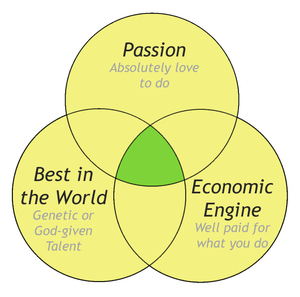
Disciplined Action is a natural result of the previous two areas: With disciplined thought and disciplined thought, a culture of discipline develops where people have simultaneous freedom and responsibility . They don't need to be micro-managed. Why? (i) they are willing to do whatever it takes, (ii) they have a high degree of self-discipline, (iii) they have unwavering belief in what they do, (iv) they know exactly what they and the company are about and where they're taking it. And they don't need forced motivation because they're aligned with the company's outcomes.
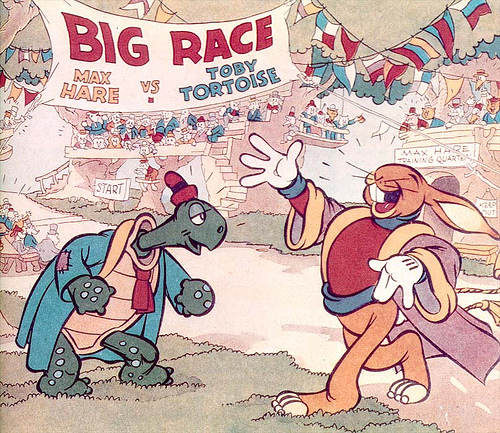
The executives of the Good To Great companies found it impossible or silly to pinpoint a single defining event that made the difference. They didn't parade grand goals to the press, nor did they have a launch party to start the transition. Instead, they just did their thing with passion and absolute commitment , allowing the transition to happen very organically.
Why try for greatness? Isn't success enough?
According to Jim Collins if you're asking that question you're in the wrong line of work. People that help make companies great, don't go for greatness because of what they get, but BECAUSE IT CAN BE DONE . They associate a meaning and passion to it so powerful that they don't see any other option but to strive for greatness. That is the main premise of the Good To Great book.
Overall, I'd say that Good To Great by Jim Collins was thoroughly enjoyable. Great insights were combined with facts as well as anecdotes of the companies that made the leap, and those that didn't. And the lessons learned here, while geared for the business arena – are readily applicable to making the leap to greatness in your own life. You can purchase the book from Amazon by clicking this link .
Project Life Mastery delivers the self-development advice you need to improve and master every area of your life.
We provide world-class content, training, and coaching to maximize the potential in your personal and business life. Everything from physical fitness, to emotional mindset, to relationships, to your financial freedom blend together to turn you into an unstoppably extraordinary person with an unstoppably extraordinary life.
Whether you need online business advice, personal development coaching, or both, Project Life Mastery will guide you on your best path to mastery.
LET’S CONNECT:
- Member Login
- Library Patron Login
SUBSCRIBE TO OUR
FREE NEWSLETTERS
Search: Title Author Article Search String:
Reviews of Good To Great by Jim Collins
Summary | Excerpt | Reading Guide | Reviews | Read-Alikes | Genres & Themes | Author Bio
Good To Great
by Jim Collins

Critics' Opinion:
Readers' Opinion:
Rate this book
Buy This Book
About this Book
- Reading Guide
Book Summary
To find the keys to greatness, Collins's 21-person research team read and coded 6,000 articles, generated more than 2,000 pages of interview transcripts and created 384 megabytes of computer data in a five-year project. The findings will surprise many readers and, quite frankly, upset others.
The Challenge Built to Last, the defining management study of the nineties, showed how great companies triumph over time and how long-term sustained performance can be engineered into the DNA of an enterprise from the very beginning. But what about the company that is not born with great DNA? How can good companies, mediocre companies, even bad companies achieve enduring greatness? The Study For years, this question preyed on the mind of Jim Collins. Are there companies that defy gravity and convert long-term mediocrity or worse into long-term superiority? And if so, what are the universal distinguishing characteristics that cause a company to go from good to great? The Standards Using tough benchmarks, Collins and his research team identified a set of elite companies that made the leap to great results and sustained those results for at least fifteen years. How great? After the leap, the good-to-great companies generated cumulative stock returns that beat the general stock market by an average of seven times in fifteen years, better than twice the results delivered by a composite index of the world's greatest companies, including Coca-Cola, Intel, General Electric, and Merck. The Comparisons The research team contrasted the good-to-great companies with a carefully selected set of comparison companies that failed to make the leap from good to great. What was different? Why did one set of companies become truly great performers while the other set remained only good? The Findings The findings of the Good to Great study will surprise many readers and shed light on virtually every area of management strategy and practice. The findings include: Level 5 Leaders: The research team was shocked to discover the type of leadership required to achieve greatness. The Hedgehog Concept (Simplicity within the Three Circles): To go from good to great requires transcending the curse of competence. A Culture of Discipline: When you combine a culture of discipline with an ethic of entrepreneurship, you get the magical alchemy of great results. Technology Accelerators: Good-to-great companies think differently about the role of technology. The Flywheel and the Doom Loop: Those who launch radical change programs and wrenching restructurings will almost certainly fail to make the leap.
"Some of the key concepts discerned in the study," comments Jim Collins, "fly in the face of our modern business culture and will, quite frankly, upset some people."
Chapter One Good is the Enemy of Great
That's what makes death so hard -- unsatisfied curiosity. --Beryl Markham, West with the Night Good is the enemy of great. And that is one of the key reasons why we have so little that becomes great. We don't have great schools, principally because we have good schools. We don't have great government, principally because we have good government. Few people attain great lives, in large part because it is just so easy to settle for a good life. The vast majority of companies never become great, precisely because the vast majority become quite good -- and that is their main problem. This point became piercingly clear to me in 1996, when I was having dinner with a group of thought leaders gathered for a discussion about organizational performance. Bill Meehan, the managing director of the San Francisco office of McKinsey & Company, leaned over and casually confided, "You know, Jim, we love Built to Last around here. You ...
Please be aware that this discussion guide will contain spoilers!
- "Beyond the Book" articles
- Free books to read and review (US only)
- Find books by time period, setting & theme
- Read-alike suggestions by book and author
- Book club discussions
- and much more!
- Just $45 for 12 months or $15 for 3 months.
- More about membership!
Media Reviews
Reader reviews.
Write your own review!
Read-Alikes
- Genres & Themes
If you liked Good To Great, try these:

by Jack Welch, Suzy Welch
Published 2006
About this book
Mr. Welch offers knowing descriptions of dilemmas and problems that are all too common in American business life, and he proposes a few ideas for solving them.

Who Says Elephants Can't Dance
by Louis Gerstner
Published 2004
The first-hand story of an extraordinary turnaround, a unique case study in managing a crisis, and a thoughtful reflection on the computer industry and the principles of leadership.
Books with similar themes
Support bookbrowse.
Join our inner reading circle, go ad-free and get way more!
Find out more

BookBrowse Book Club

Members Recommend

The Stolen Child by Ann Hood
An unlikely duo ventures through France and Italy to solve the mystery of a child’s fate.

This Strange Eventful History by Claire Messud
An immersive, masterful story of a family born on the wrong side of history.
Win This Book

Only the Brave by Danielle Steel
A powerful, sweeping historical novel about a courageous woman in World War II Germany.
Solve this clue:
and be entered to win..
Your guide to exceptional books
BookBrowse seeks out and recommends the best in contemporary fiction and nonfiction—books that not only engage and entertain but also deepen our understanding of ourselves and the world around us.
Subscribe to receive some of our best reviews, "beyond the book" articles, book club info and giveaways by email.
- Non-Fiction
- Author’s Corner
- Reader’s Corner
- Writing Guide
- Book Marketing Services
- Write for us
Good to Great by James C. Collins
Why Some Companies Make the Leap...and Others Don't
Title: Good to Great
Author: James C. Collins
Publisher: Harper Business
Genre: Business, Strategy
First Publication: 2001
Language: English
Book Summary: Good to Great by James C. Collins
To find the keys to greatness, Collins’s 21-person research team read and coded 6,000 articles, generated more than 2,000 pages of interview transcripts, and created 384 megabytes of computer data in a five-year project. The findings will surprise many readers and, quite frankly, upset others.
The Challenge
Built to Last, the defining management study of the nineties, showed how great companies triumph over time and how long-term sustained performance can be engineered into the DNA of an enterprise from the very beginning.
But what about the company that is not born with great DNA? How can good companies, mediocre companies, and even bad companies achieve enduring greatness?
For years, this question preyed on the mind of Jim Collins. Are there companies that defy gravity and convert long-term mediocrity, or worse, into long-term superiority? And if so, what are the universal distinguishing characteristics that cause a company to go from good to great?
The Standards
Using tough benchmarks, Collins and his research team identified a set of elite companies that made the leap to great results and sustained those results for at least fifteen years. How great? After the leap, the good-to-great companies generated cumulative stock returns that beat the general stock market by an average of seven times in fifteen years, better than twice the results delivered by a composite index of the world’s greatest companies, including Coca-Cola, Intel, General Electric, and Merck.
The Comparisons
The research team contrasted the good-to-great companies with a carefully selected set of comparison companies that failed to make the leap from good to great. What was different? Why did one set of companies become truly great performers while the other set remained only good?
The Findings
The findings of the Good to Great study will surprise many readers and shed light on virtually every area of management strategy and practice. The findings include: Level 5 Leaders: The research team was shocked to discover the type of leadership required to achieve greatness.
The Hedgehog Concept (Simplicity within the Three Circles): To go from good to great requires transcending the curse of competence.
A Culture of Discipline: When you combine a culture of discipline with an ethic of entrepreneurship, you get the magical alchemy of great results. Technology Accelerators: Good-to-great companies think differently about the role of technology.
The Flywheel and the Doom Loop: Those who launch radical change programs and wrenching restructurings will almost certainly fail to make the leap.
Book Review: Good to Great by James C. Collins
Published in 2001, “ Good to Great: Why Some Companies Make the Leap…and Others Don’t ” by business consultant and author Jim Collins takes an in-depth look at what separates outstanding companies from the merely good. The book is based on a comprehensive 5-year research project examining companies that made the leap from good performance to great results, sustaining that leap for at least 15 years.
Collins and his research team identified 28 companies that transitioned from good to great results and sustained the performance. They compared these companies to a set of comparison companies in the same industries to understand what differentiated the good-to-great companies. The findings detail the key factors, behaviors, and processes required to make the transition from good to truly great.
The book presents insightful concepts like the flywheel effect, the hedgehog concept, and Level 5 leadership. Collins suggests companies need several key ingredients—disciplined people, the right priorities, a culture of excellence, and high-quality leadership—to start and sustain the flywheel towards superior performance. Overall, the book makes a data-driven and compelling case for the attributes shared by companies that achieve enduring greatness.
The Research Project
Collins details the comprehensive research effort undertaken by his 21-person research team. To identify companies that had transitioned from good performance to great results, Collins started with a list of 1,435 established companies and narrowed the list down based on specific criteria.
Eligible companies needed to demonstrate the good-to-great pattern: 15-year cumulative returns at or below market, followed by 15-year returns at least three times the market. Furthermore, the transition point from good to great needed to be obvious. Collins identified 11 good-to-great companies from a diverse mix of industries that met these demanding criteria.
To provide comparisons, the team also selected peer companies in the same industries with similar opportunities and resources. However, these comparison companies failed to make the good-to-great leap. Examining direct comparisons enabled Collins to differentiate luck or industry conditions from the crucial drivers for making the shift.
In total, Collins and his team exhaustively analyzed the performance, leadership, practices, and transitions of 28 companies ( 11 good-to-great and 17 comparisons ). The book shares the key discoveries and learning from 85 interviews with senior executives across the 28 companies during the 5-year research effort.
Key Concepts: Level 5 Leadership, Flywheel, and Hedgehog Concept
Collins introduces several compelling ideas that underpin the transition from good to great. Among the most noteworthy are the concepts of Level 5 leadership, the flywheel effect, and the hedgehog concept.
Level 5 Leaders
One of the most central findings from the research highlights the importance of leadership, specifically what Collins terms as “Level 5 leadership.” . The study found every good-to-great company had Level 5 leadership during pivotal transitions.
These leaders display a powerful mixture of humility and intense professional will. They are ambitious for the company and its success rather than themselves. Additionally, they have the ability to set up their successors and the company for enduring success. Collins contrasts Level 5 leaders with other types, like highly charismatic or celebrity leaders, who often fail to transition an organization to greatness.
The Flywheel Effect
Collins describes the flywheel effect to capture the momentum great companies develop over time. The flywheel depicts the deliberate process where organizations slowly build connections to accelerate performance.
With Level 5 leaders at the helm, great companies bring a methodical approach to understanding capabilities, building the right culture and people, and driving performance. Bit by bit, these interconnected elements combine to propel exceptional results – much like the compounding effects of a flywheel picking up speed.
The Hedgehog Concept
The hedgehog concept refers to great companies’ ability to simplify complex environments into a basic principle guiding their priorities. Collins draws upon the ancient Greek parable – “the hedgehog knows one big thing” – to describe the single-minded focus driving great companies.
Great companies are able to ignore distractions and complexity to operate within their hedgehog concept. Their simplified lens helps them understand what best aligns with their mission and capabilities for driving performance. Maintaining fierce consistency with their hedgehog concept is vital for delivering great results.
Key Findings: People, Priorities, and Performance
At their core, Collins finds great companies have three dimensions firmly in place: the right people, the right priorities, and performance orientation.
Great companies are rigorous, not rigid, on talent. They adhere to disciplined recruiting and consistently let go of people not fulfilling expectations. However, they avoid constraining boundaries, considering great performers regardless of background or experience.
Additionally, great companies remain centered on priorities tied directly to their mission and profit drivers rather than exploring peripheral initiatives. They also enable broad employee participation to reinforce the right drivers.
Finally, great companies build a focused, performance-oriented culture oriented around collaboration and the flywheel effect. They blend relentless expectations with employee development and collective achievement. This forms the cornerstone, allowing disciplined action and alignment to compound over time.
Surprising Results and Key Takeaways
Collins highlights several important conclusions for driving organic company success while dispelling common leadership misconceptions.
First and foremost, Collins found acquiring star executives from high-profile companies was negatively correlated with ascending from good to great. Great companies favored development from within rather than flashy outside hires.
Furthermore, many common leadership approaches failed to stimulate greatness. Driving change through radical, dramatic moves rarely propelled great results. Similarly, Collins found greatness did not stem from visionary, celebrity-status leaders who frequently derail momentum.
Instead, Collins emphasizes the marathon-like process where Level 5 leaders channel collective focus towards long-term goals rather than short-term gains. Sustaining the right people and culture facilitates this. With upfront communication and consistency, change management happens gradually as employees rally around the flywheel’s momentum.
Finally, perhaps Collins’ most important takeaway is that great results stem foremost from conscious choice and discipline. Company leaders choose greatness by implementing sound, deliberate decisions driven by focus – not circumstance. With the right people and the right collective discipline, Collins suggests nearly any organization can propel from good to insanely great results over time.
While Collins’s book highlights several poignant conclusions, it leaves some areas open to criticism. Most prominently, several researchers have questioned whether Collins’s key findings can reliably apply across more diverse company types.
The companies examined in the study consisted primarily of conventional consumer brands and industrial firms. Critics argue service firms and technology companies operate under different circumstances that limit the relevance of concepts like the flywheel.
Additionally, some analysis has suggested a company’s greatness may simply stem from establishing dominance through scale early within an industry. Consequently, smaller players may struggle to replicate good-to-great trajectories.
Finally, since Collins’s publishing, companies spotlighted like Circuit City and Fannie Mae have faltered, conflicting with the book’s view of 10X success and sustained trajectories. This arguably limits the universality of the monolithic good-to-great model.
However, supporters counter that Collins examines long-term transitions, not indefinite outcomes. Regardless of latter turmoil, these companies still demonstrated the good-to-great shift and decade-plus greatness initially.
Two decades after its release, “Good to Great” remains widely esteemed as one of the most insightful business leadership books . Collins put together an ambitious, data-driven analysis of what differentiated the most successful, enduring companies.
The book highlighted compelling and counterintuitive insights around talent, leadership, change management, culture, and the focus required to achieve greatness. While elements rightfully warrant skepticism and continued examination, few works provide such an extensively researched and detailed look at the drivers, execution, and disciplines yielding large-scale company success.
For these reasons, both business executives and academic communities continue to study it. While debate remains on some findings, the core concepts help provide a blueprint for organizations aiming to implement cultural identity, practices, and leadership, enabling the ascendance to sustained, superior results leveling companies like Fannie Mae and others never reached or maintained.
Leave a reply cancel reply.
Sign me up for the newsletter!
Readers also enjoyed
The handmaid’s tale by margaret atwood, never let me go by kazuo ishiguro, it by stephen king, special delivery by damon lamorea, the perfect marriage by jeneva rose, popular stories, one day, life will change by saranya umakanthan, most famous fictional detectives from literature, the complete list of the booker prize winner books, book marketing and promotion services.
We provide genuine and custom-tailored book marketing services and promotion strategies. Our services include book reviews and social media promotion across all possible platforms, which will help you in showcasing the books, sample chapters, author interviews, posters, banners, and other promotional materials. In addition to book reviews and author interviews, we also provide social media campaigning in the form of contests, events, quizzes, and giveaways, as well as sharing graphics and book covers. Our book marketing services are very efficient, and we provide them at the most competitive price.
The Book Marketing and Promotion Plan that we provide covers a variety of different services. You have the option of either choosing the whole plan or customizing it by selecting and combining one or more of the services that we provide. The following is a list of the services that we provide for the marketing and promotion of books.
Book Reviews
Book Reviews have direct impact on readers while they are choosing their next book to read. When they are purchasing book, most readers prefer the books with good reviews. We’ll review your book and post reviews on Amazon, Flipkart, Goodreads and on our Blogs and social-media channels.
Author Interviews
We’ll interview the author and post those questions and answers on blogs and social medias so that readers get to know about author and his book. This will make author famous along with his book among the reading community.
Social Media Promotion
We have more than 170K followers on our social media channels who are interested in books and reading. We’ll create and publish different posts about book and author on our social media platforms.
Social Media Set up
Social Media is a significant tool to reaching out your readers and make them aware of your work. We’ll help you to setup and manage various social media profiles and fan pages for your book.
We’ll provide you our social media marketing guide, using which you may take advantage of these social media platforms to create and engage your fan base.
Website Creation
One of the most effective and long-term strategies to increase your book sales is to create your own website. Author website is must have tool for authors today and it doesn’t just help you to promote book but also helps you to engage with your potential readers. Our full featured author website, with blog, social media integration and other cool features, is the best marketing tool you can have. You can list each of your titles and link them to buy from various online stores.
Google / Facebook / Youtube Adverts
We can help you in creating ad on Google, Facebook and Youtube to reach your target audience using specific keywords and categories relevant to your book.
With our help you can narrow down your ads to the exact target audience for your book.
For more details mail us at [email protected]
The Bookish Elf is your single, trusted, daily source for all the news, ideas and richness of literary life. The Bookish Elf is a site you can rely on for book reviews, author interviews, book recommendations, and all things books. Contact us: [email protected]
Quick Links
- Privacy Policy
Recent Posts
Why leaflets are essential for small business marketing.
Good To Great by Jim Collins Book Summary & Review
Good is often the enemy of great in business. the vast majority of companies never become great because they’re satisfied with good results. so, good to great aims to address the question, “how can a good company become a great company”.
Author Jim Collins and his team sought to identify organizations that had made the transition from good-to-great. They analyzed publicly-traded companies looking for those that matched the following pattern: fifteen-year cumulative stock returns at or below the general stock market, punctuated by a transition point, then cumulative returns at least 3x the market over the next fifteen years.
Each company had to demonstrate the good-to-great pattern independent of its industry. If the whole industry showed the same pattern, the company was dropped from consideration. In the end, eleven good-to-great companies were found.
Critically, the team also found two sets of comparison companies. The first set was “direct comparisons” in the same industry as their good-to-great counterparts (but did not show a leap). The second was “unsustained comparisons” that made a short-term shift from good-to-great but failed to maintain the trajectory.
The critical question was, “What did the good-to-great companies share in common that distinguished them from the comparison companies?”
The core concepts of this book were developed by making empirical deductions from the data. It was an iterative process of developing ideas and testing them against the data, revising the ideas, building a framework, seeing it break, and rebuilding it yet again. In the end, the following framework was born.
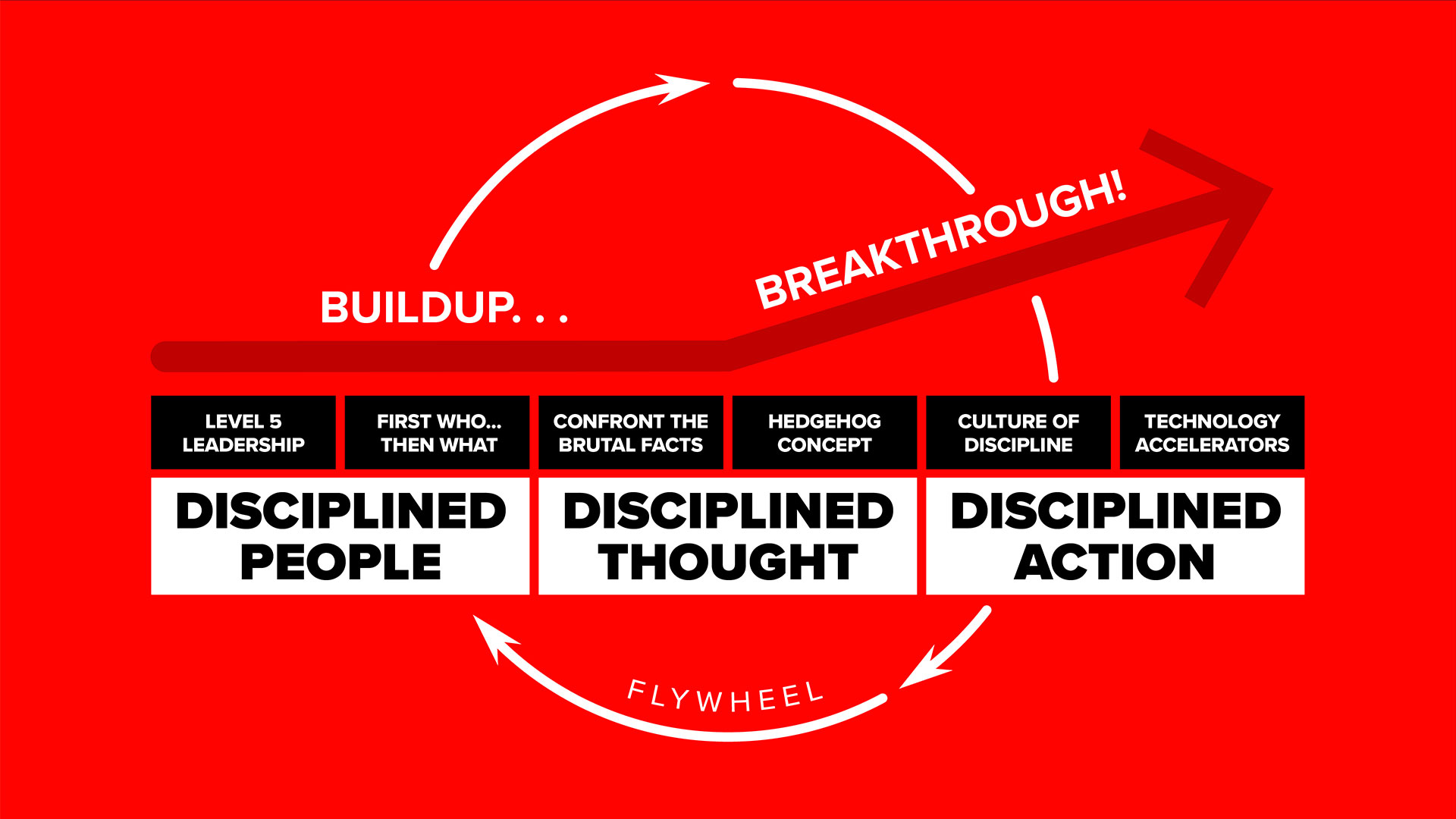
The model includes three stages: disciplined people, disciplined thought, and disciplined action. Within each stage are two key concepts. Wrapping around the entire model is “The Flywheel,” which brings everything together.
Concept 1: Level 5 Leadership

All of the good-to-great companies had Level 5 Leadership at the time of transition. This form of leadership is a unique combination of personal humility and professional will. Such leaders have incredible ambition for the company and its success rather than for their fame or fortune.
Here are the five levels of leadership as described in the book (1-5):
- Highly Capable Individual – Makes productive contributions through talent, knowledge, skills, and good work habits.
- Contributing Team Member – Contributes individual capabilities to the achievement of group objectives and works effectively with others.
- Competent Manager – Organizes people and resources toward the effective and efficient pursuit of predetermined objectives.
- Effective Leader – Catalyzes commitment to and vigorous pursuit of a clear and compelling vision, stimulating higher performance standards.
- Level 5 Executive – Builds enduring greatness through a paradoxical blend of personal humility and professional will.
Level 5 leaders channel their ego needs away from themselves and into the goal of building a great company. It’s not that they don’t have an ego or self-interest, but rather that their ambition is first and foremost for the institution, not themselves. As a result, they set up their successors for even better results in the next generation.
“You can accomplish anything in life, provided that you do not mind who gets the credit. “ Harry S. Truman
Note: Larger-than-life celebrity leaders who ride in from the outside are negatively correlated with going from good to great. Ten of eleven good-to-great CEOs came from inside the company, whereas the comparison companies brought in outside leadership six times more often. Such leaders, concerned more with their reputation for personal greatness, often failed to set their companies up for success.
Level 5 leaders would humbly attribute success to factors outside of themselves. But, when things go poorly, they would blame themselves, taking full responsibility. The comparison company CEOs often did just the opposite, taking credit for successes while blaming others for disappointing results.
Concept 2: First Who… Then What

The executives who ignited good-to-great transformations started by first getting the right people on the bus (and the wrong people off the bus) and then figured out where to drive it. The reason is that when you begin with “who” rather than “what,” you can more easily adapt to an ever-changing world.
To be clear, the key takeaway here is not just hiring the right people. Instead, it’s that hiring the right people comes before determining vision, strategy, structure, or tactics. Such people should be recruited primarily for their character and work ethic rather than for education, skills, or knowledge that can be acquired on the job.
Here are three practical disciplines for making people decisions:
- When in doubt, don’t hire and keep looking.
- When you know that you need to make a change, act.
- Put your best people on your biggest opportunities, not your biggest problems.
When you have the right people, the problem of how to motivate and manage largely goes away. The right people don’t need to be tightly managed or fired up. They are self-motivated and capable of generating results. So, create an environment where hardworking people can thrive, and lazy workers jump ship or are let go.
To be clear, having great people doesn’t mean they will always agree with each other. It’s best if they fiercely debate ideas in pursuit of the best answers to organizational questions. And then, when all is said and done, unify fully behind final decisions, regardless of personal interests.
For contrast, comparison companies often took the “genius with a thousand helpers” approach. A bold leader would set the vision and then coordinate with “helpers” to turn it into reality. Unfortunately, this approach falls apart whenever the leader leaves the organization.
Concept 3: Confront The Brutal Facts

Companies cannot make great decisions without first confronting reality. When leaders manufacture their own reality instead of acknowledging the brutal facts, they create a recipe for mediocrity, or worse. On the other hand, when you start with an honest effort to determine the truth of a situation, the right decisions often become self-evident.
Here are four ways to create a climate where truth is heard:
- Lead with questions, not answers.
- Engage in dialogue and debate, not coercion.
- When mistakes happen, conduct autopsies without blame.
- Build “red flag” mechanisms to gather critical feedback.
Every good-to-great company faced significant adversity along the way to greatness. In confronting the brutal facts, they left themselves stronger and more resilient, not weaker and more discouraged. There is a sense of exhilaration that comes in facing the hard truths and saying, “we will never give up.”
It’s essential to strike a balance between confronting the most brutal facts of your current reality and retaining absolute faith that you can and will prevail. This is referred to as the Stockdale Paradox, and it’s vital for leading a company from good to great.
Concept 4: The Hedgehog Concept

The good-to-great companies were like hedgehogs: simple, dowdy creatures that had “one core strategy” and stuck to it. The comparison companies were more like foxes: crafty, cunning creatures that know many things yet lack consistency.
“The fox knows many things, but the hedgehog knows one big thing.” Ancient Greek Parable
The Hedgehog Concept is a tool for identifying your own simple, crystalline concept. It’s based on developing a deep understanding of three circles: (1) what you’re deeply passionate about, (2) what you can be the best in the world at, and (3) what drives your economic or resource engine.
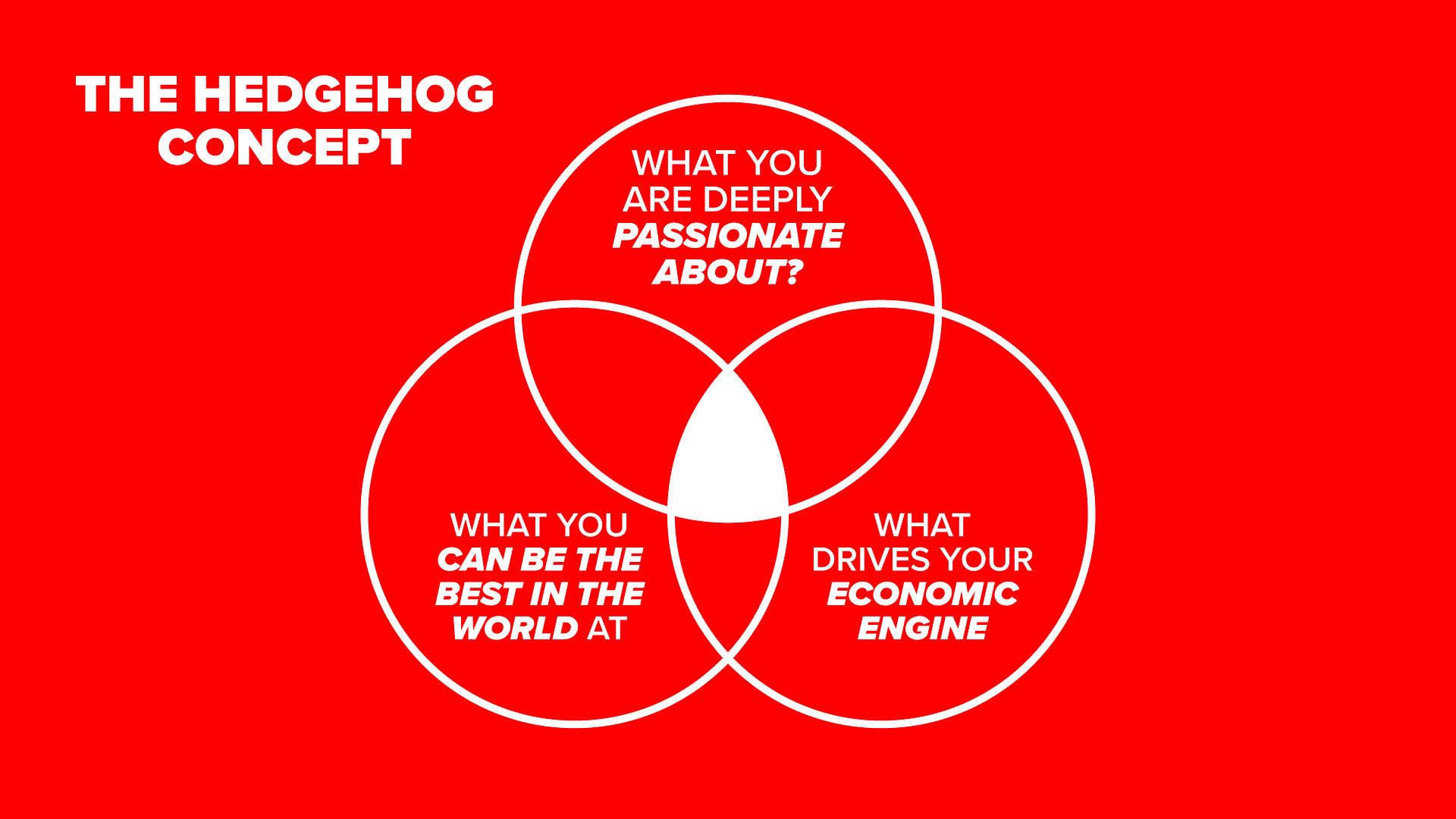
Circle 1: What Are You Deeply Passionate About?
Good-to-great companies focused on the activities that ignite their passion. The idea here is not to stimulate passion but to discover what makes you passionate. You can’t manufacture passion or “motivate” people to feel passionate. You can only discover what you and your team are already passionate about.
Circle 2: What Can You be The Best At?
Every company would like to be the best at something, but few understand with total clarity what they have the potential to be best at. It’s not about coming up with a goal to be the best, a strategy to be the best, or an intention to be the best. It’s about identifying what you can truly be the best at. The distinction is critical.
Circle 3: What Drives Your Economic Engine?
Every organization must understand how to generate sustained cash flow. To gain insight into the drivers of your economic engine, search for the one denominator that has the single most significant impact. Some examples that may be relevant include:
- Profit per customer.
- Profit per employee.
- Profit per retail location.
- Profit per square foot.
- Profit per geographic region.
- Profit per product.
Identify The Overlap Between The Three Circles
All of the good to great companies understood that the essence of profound insight is simplicity. They identified their Hedgehog Concept and used it as a frame of reference for future decisions. While it sometimes took years for the concept to come together, the eventual discovery coincided with breakthrough results.
Concept 5: A Culture Of Discipline

The ability to sustain great results depends on building a culture of discipline. This involves disciplined people, disciplined thought, and disciplined action. Each plays a critical role in allowing an organization to thrive with minimal bureaucracy.
Disciplined People
Everything starts with great people. Avoid trying to discipline the wrong people into taking the correct actions. Instead, identify self-disciplined people that are willing and able to go to extreme lengths to fulfill their responsibilities.
Disciplined Thought
Organizations must also be disciplined around: confronting brutal facts, remaining resilient, and identifying a clear Hedgehog Concept. When it comes to achieving sustained results, the most essential of the three is having a fanatical adherence to the Hedgehog Concept and the willingness to shun opportunities that don’t fit.
Disciplined Action
A culture of discipline involves a duality. On the one hand, it requires that people adhere to a consistent system. On the other hand, it gives people freedom and responsibility with the framework of that system. Thus, a culture of discipline is not just about taking action but ensuring those actions contribute to a larger whole.
The good-to-great companies at their best followed a simple mantra: “Anything that does not fit with our Hedgehog Concept, we will not do. We will not launch unrelated businesses. We will not make unrelated acquisitions. We will not do unrelated joint ventures. If it doesn’t fit, we don’t do it. Period.”
The more an organization has the discipline to stay within its three circles, the more it will have attractive growth opportunities. So the key to a disciplined culture is to give great people the freedom to take action within a well-defined Hedgehog Concept.
Concept 6: Technology Accelerators

When used correctly, technology becomes an accelerator of momentum, not a creator of it. The good-to-great companies never began their path to greatness by pioneering technology just for the sake of innovation. Instead, they understood that you cannot make good use of technology until you know which technologies are relevant.
The critical question is, “Does this technology fit directly with the Hedgehog Concept?”
If yes, then you need to become a pioneer in the application of that technology. If no, then ask, do you need this technology at all? If yes, then all you need is parity (you don’t need the world’s most advanced phone system to be a great company). If no, then the technology is irrelevant, and you can ignore it.
Good-to-great organizations avoided technology fads and bandwagons, yet they become pioneers in the application of carefully selected technologies. The thoughtless pursuit of technology is a liability, not an asset. Innovation alone cannot turn a good enterprise into a great one. Nor by itself can it prevent disaster.
The Flywheel and The Doom Loop
While good-to-great transformations often look dramatic from the outside, they feel like organic, cumulative processes to the people on the inside. It’s very comparable to the time and effort required to get a heavy flywheel spinning.
The Flywheel
Imagine a huge flywheel mounted horizontally on an axle, 30 feet in diameter, 2 feet thick, and 5,000 pounds in weight. Any effort to get it rotating necessarily starts with tremendous effort and minimal movement. However, so long as you continue pushing in the same direction, the task becomes easier as the wheel builds momentum.

The same is true when it comes to business. As you build momentum in a clear direction, the challenges around organizational commitment, alignment, and motivation begin to melt away. They essentially take care of themselves as team members start to see visible, tangible results build up over time.
The Doom Loop
Unfortunately, the comparison companies weren’t able to build momentum. They spent years bouncing back and forth between various strategies instead of making consistent progress in one direction. As a result, they fell into what is called The Doom Loop.
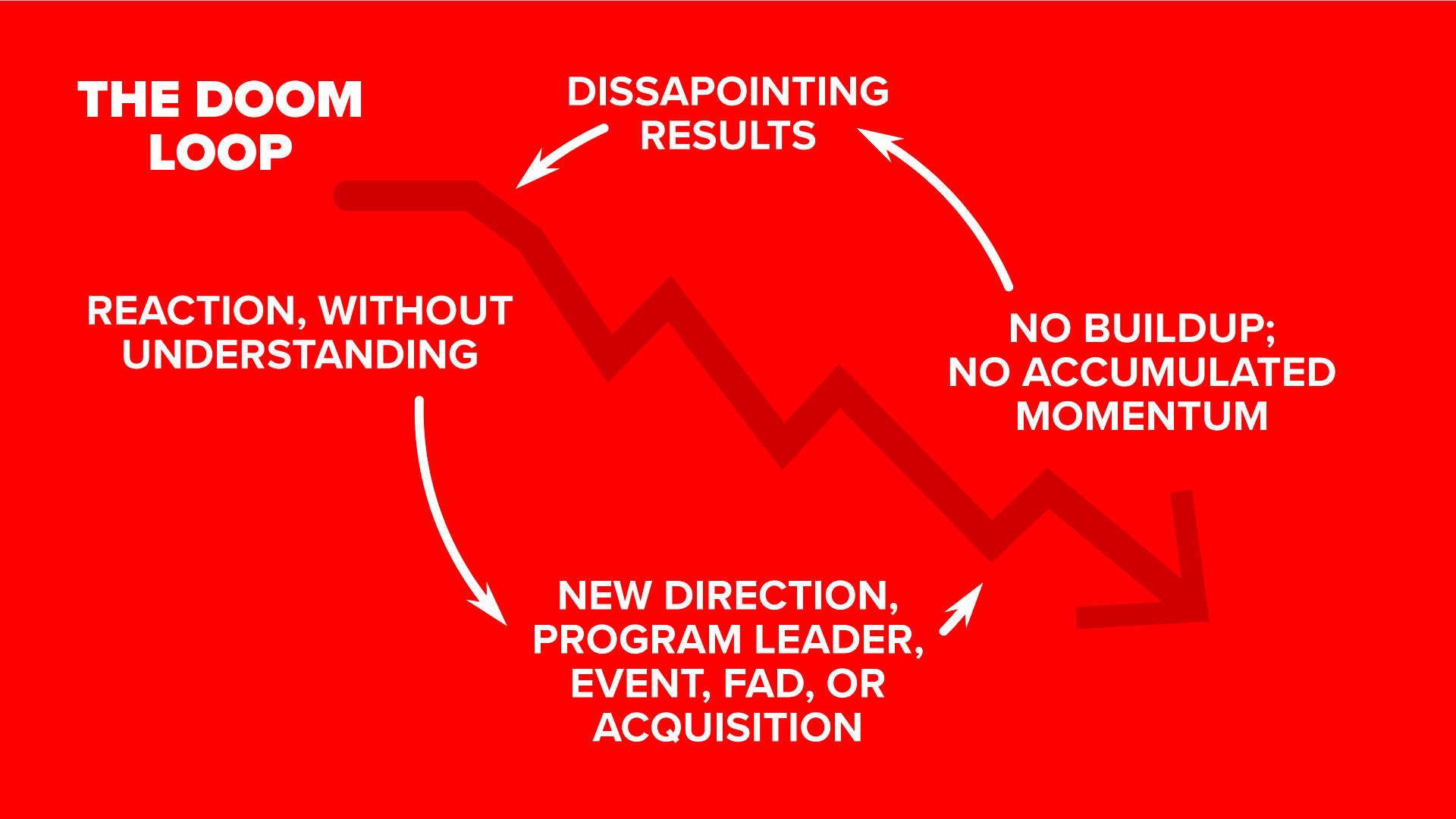
Rather than accumulating momentum, the comparison companies tried to skip the buildup process to jump directly into a breakthrough. Then, with disappointing results, they’d lurch back and forth, getting stuck in a downward spiral of trying new things.
How To Build Momentum
Each piece of the Good To Great system reinforces the other parts to form an integrated whole. The initial buildup begins with Level 5 Leadership, getting the right people on the bus, and confronting the brutal facts. Eventually, the Hedgehog Concept comes into focus, and then breakthrough results can begin with a culture of discipline and effective use of technology.
Beyond The Good To Great Book Summary
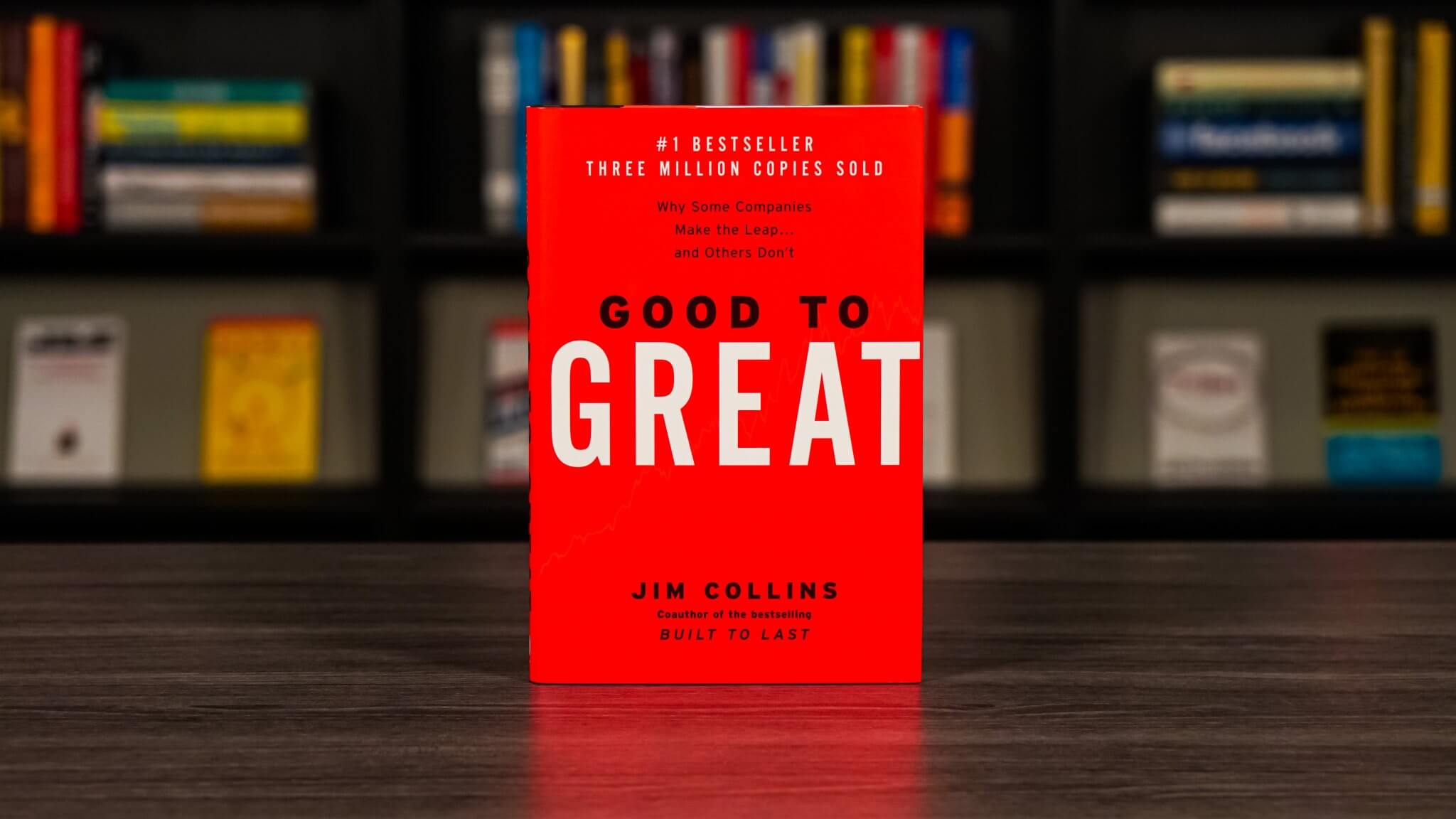
This summary is just a preview of what to expect from Good To Great. It’s not a substitute for reading the book because the original text provides a much richer learning experience. If you’re serious about applying these ideas, I strongly recommend that you pick up a copy .
Good To Great is available from Amazon and Apple Books .
Are you looking for another great book? Consider checking out the best leadership books , the best management books , or the best business books .
You can also subscribe to The Rick Kettner YouTube Channel or The Rick Kettner Podcast to get updates about future book summaries and reading lists.
Do You Have A Question Or Comment?
Please visit the Good To Great summary on YouTube to share your thoughts in the comment section.
Rick Kettner
Rick is an avid reader and lifelong entrepreneur. He co-founded popular online music education platforms including Drumeo, Pianote, and Guitareo. He now spends much of his time sharing tips on business strategy, marketing, and entrepreneurship.
You may also like

Range by David Epstein Book Summary

Peak by Anders Ericsson and Robert Pool Book Summary

The Serendipity Mindset by Christian Busch Book Summary
#ezw_tco-5 .ez-toc-title{ font-size: ; font-weight: ; color: ; } #ezw_tco-5 .ez-toc-widget-container ul.ez-toc-list li.active{ background-color: #ededed; } table of contents.

Book Review: Good to Great by Jim Collins: Learn how companies achieve excellence
33 pages, Kindle Edition
Published March 16, 2017
About the author

Ratings & Reviews
What do you think? Rate this book Write a Review
Friends & Following
Community reviews, join the discussion, can't find what you're looking for.

7 Lessons from Good to Great
Influential management professor Jim Collins released the popular Good to Great: Why Some Companies Make the Leap…and Others Don’t in 2001. The book is really a research project led by Collins as a follow-up to his book Built to Last: Successful Habits of Visionary Companies . He researched hundreds of companies to identify sets of “good” companies where one became “great” while a close competitor failed. Collins and his team tried to discover what the “great” companies did differently from the comparison companies and the general market.
The book is a bestseller that has become a management strategy classic on how to grow a successful company and our team has given the book as a gift to numerous organizational leaders. Key points can be summarized by the image below – this post will summarize the key lessons any top executive can follow.
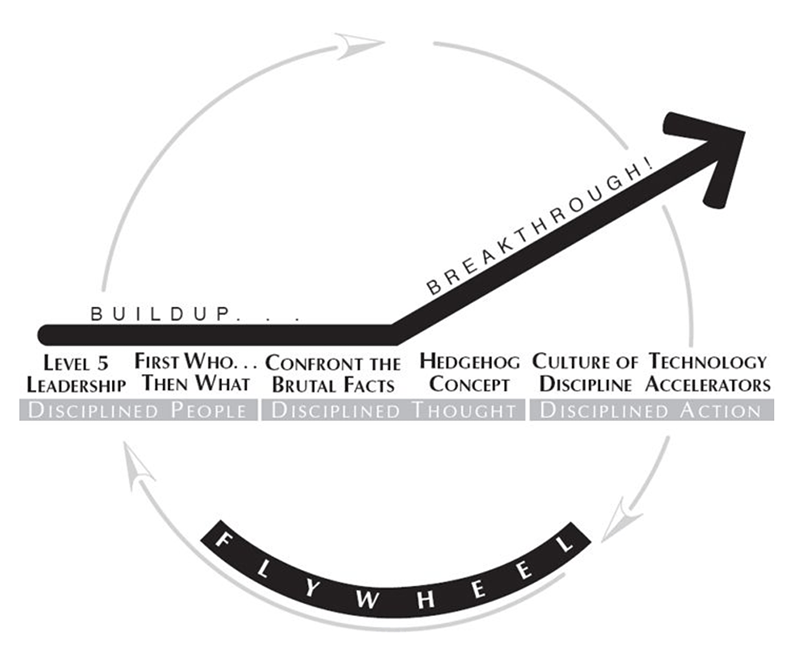
The Flywheel from Good to Great by Jim Collins
Collins learned that factors such as CEO compensation, technology, mergers and acquisitions, and change management initiatives played relatively minor roles in moving from Good to Great . Instead, Collins found that successes resulted from three main factors:
- disciplined people
- disciplined thought
- disciplined action
The book’s chapters cover each part of the Flywheel image and explain how the Great companies achieved breakthrough results. Lean East has summarized each chapter into a single lesson and converted the lessons into a process that can transform an organization from Good to Great .
Disciplined People
Level 5 Leadership : Jim Collins found a common characteristic of the great companies was great leadership. Specifically, Collins defined “Level 5 Leadership” as a key to moving from good to great.
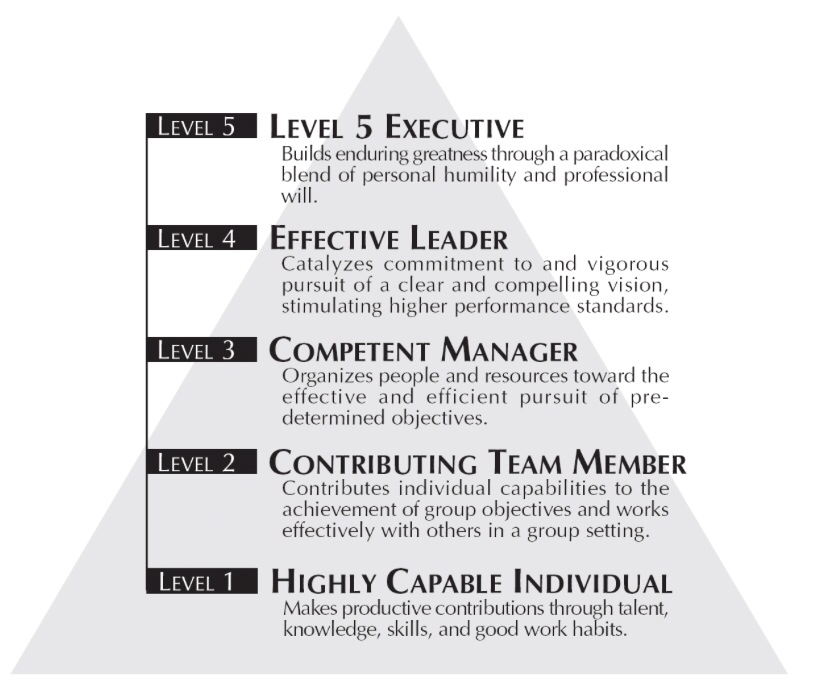
Level 5 leaders achieve better results than the “strategic and effective” Level 4 leaders. Level 5 leaders also have intense determination and profound humility. They remain humble learners while having a steadfast resolve. Level 5 leaders establish a set of core values focused on a higher purpose than mere profit generation. Collins found these leaders were committed to the long-term success of their organizations, and many rose to a leadership role from within the company.
“Mix personal humility with professional will”
Get the right people on the bus : People assume that new business leaders immediately begin by announcing where they’re going—by setting a new direction or by articulating a fresh corporate vision. In fact, the leaders of companies that went from good to great started not with “where” but with “who.” Start by getting the right people on the bus, the wrong people off the bus, and the right people in the right seats. Then review the core values and establish a vision.
“First Who, then What?”
Disciplined Thought
Confront the Brutal Facts : Companies transitioning from Good to Great must be willing to identify and assess defining facts in the company and in the larger business environment. Collins outlines a four-step process to promote awareness of emerging trends and potential problems:
1) Lead with questions, not answers.
2) Engage in dialogue and debate, not coercion.
3) Conduct autopsies without blame.
4) Build red flag mechanisms that turn information into information that cannot be ignored.
“Become aware of emerging market trends and potential problems”
The Hedgehog Concept : Simplicity leads to greatness. When confronted by predators, the hedgehog’s instinct is to curl up into a protective ball. This single response is simple and works as a response to any attack. To transition from Good to Great , companies should focus on doing one thing better than anyone else in the world. This single-function will become the organization’s “Hedgehog Concept.”
Collins suggests the following steps to help expedite this process:
- Determine what you can be best in the world at and what you cannot be best in the world at
- Determine what drives your economic engine
- Determine what you are deeply passionate about
“Do one thing better than anyone else”
Disciplined Action
A Culture of Discipline : Sustained great results depend upon an overarching organizational culture of discipline. The single most important discipline is fanatical adherence to the Hedgehog Concept by shunning opportunities that do not meet your singular “better than anyone else” criteria.
Disciplined thought followed by disciplined action is required. Do not assume this requires a tyrant leader who disciplines – this leads to highly dysfunctional organizations. Every team member is rather afforded the degree of personal empowerment and latitude that is necessary to bring the firm’s envisioned objectives into existence.
“Focus all your resources toward that area of strength”
Technology Accelerators : Good to Great organizations think differently about technology. They avoid fads, instead focusing on where technology can be an accelerator of momentum within the firm’s Hedgehog Concept. None of the Good to Great companies Jim Collins studied began their transformations with pioneering technology, yet they all became pioneers in the application of technology once they fit it within their Hedgehog Concept.
Collins characterizes the ideal approach to technology with the following cycle: “Pause — Think — Crawl — Walk — Run.”
“Carefully apply technologies that accelerate your key strength”
The Good to Great Process
The flywheel effect : A Good to Great transformation looks dramatic to customers and the market, but the beginnings may be unnoticed inside the company. The process is akin to pushing a large, heavy flywheel. It takes a lot of effort to get started and build energy, but with persistent pushing in a consistent direction over a long period, the flywheel builds momentum and eventually can’t be stopped – achieving breakthrough results.
Making decisions and taking actions that reinforce and affirm the company’s Hedgehog competencies initiate positive momentum. This results in the accumulation of tangible positive outcomes and serves to energize and earn the loyalty of the staff.
In contrast to the flywheel effect, the doom loop is characterized by reactive decision-making, an overextension into too many diverse areas of concentration, following short-lived trends, frequent changes in leadership and personnel, loss of morale, and disappointing results.
“Steady, consistent progress leads to eventual breakthrough”
The Good to Great process : The seven lessons from the book result in a basic process, as shown below.
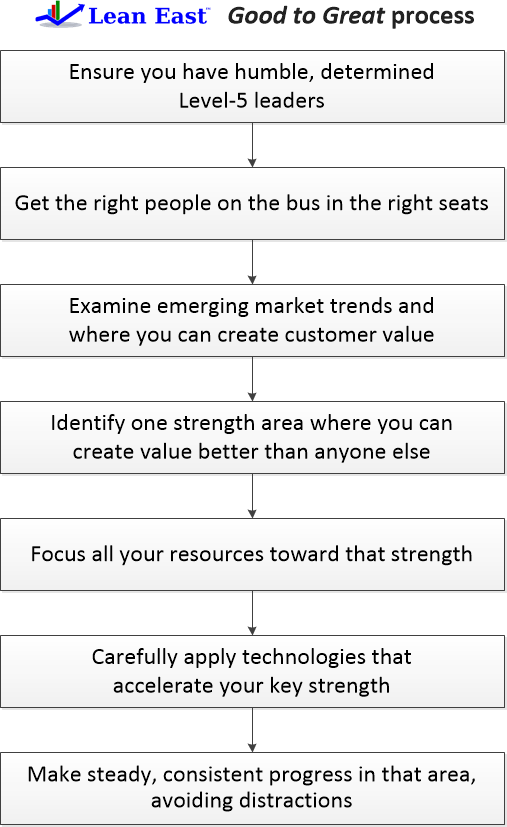
From Good to Great
The Lean East team would love to hear from any leaders who have used the ideas in this book to transform their organizations. This process takes time to see true results. We are concerned that many organizations and leaders do not have the patience and discipline to keep pushing, especially at the beginning when results are hard to see.
Check out the other studies by Jim Collins: Built to Last and Great by Choice .
Are you a founder, leader, or employee of a smaller, private company? Check out our 7 Lessons from Small Giants: Companies That Choose To Be Great Instead of Big by Bo Burlingham.
Please subscribe to our newsletter for monthly book summaries and learnings from our team. We will update our blog to share our experiences working with several companies currently on this journey soon.
14 thoughts on “ 7 Lessons from Good to Great ”
Great summary and great insights. Thanks a lot for sharing.
Great insights of the book! one question: Are these Level 5 Leadership inspired von J. C. Maxwell’s 5-Levels of Leadership? I am looking forward to reading your answer Greetings, Ria
Hi Ria, We are very happy that you enjoyed our summary of Good to Great! We suspect that Collins was aware of and inspired by Maxwell’s levels of leadership. Note that there are similarities, but they are not the same thing . . . Best, Steve
Good summary. Thanks for sharing with us.
Thanks for this excellent summary.
We are going through this process right now at Big West Marketing.
Hi Jordan, I would love to hear more about your Good to Great journey.
What is going well? What could go better? What have you learned?
Please leave more info in a new comment below or email me privately. Thanks, [email protected]
Is it possible to achieve this with staff who you cannot remove from posts if performance is an issue? I work in the social sector and have staff which will not or cannot be moved, but still looking to achieve this improvement. I know the right people on the bus mentality, but will that ever be an option if the wrong people are on the bus, or is it possible to convert them to the right people??
Hi Allan, We have supported social sector organizations and often have to deal with constraints, including around workforce contracts. We would need to discover the root cause problems in order to answer your questions. Why did the wrong people get on the bus? Do the people know where the bus is going? Did the bus change direction? Some social sector clients we have worked with don’t know some of these basics facts about the organization.
Attempting to convert “wrong” people into “right” people requires bureaucracy which ultimately destroys the culture of discipline and drives away self motivated staff who don’t want to be micromanaged. That’s what the research in the book indicates.
Thanks for Sharing with us, I’ve started to embark in this yesterday of Moving from Good to Great with our Coach at work. This is not an easy task but as you mentioned that when you start spinning a wheel in the beginning it not easy but eventually when the goes on it became easy, so yeah I am looking forward to learn more from “Good to Great “.
Thanks for your comment! Yes, it takes time to develop the right habits and build momentum but once you do you will be unstoppable!
[…] Rather than accumulating momentum, they struggle to skip buildup and jump immediately to breakthrough with one-off tactics that give them immediate but short-term results. […]
[…] 7 Lessons from Good to Great […]
I agree that you shouldn’t be reactionary to business swings. I need a consultant to help us out in the office. I’ll have to consider getting a consultant to help me out with detecting fraud in the department.
Leave a Reply Cancel reply
Your email address will not be published. Required fields are marked *
Related Posts
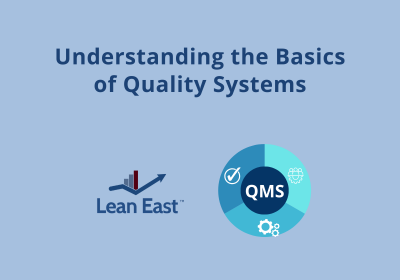
Understanding the Basics of Quality Systems

Leveraging Generational Differences in the Workplace

This Is More Important Than An Original Idea
Join the NEW Personal Kaizen community!

Our community is here to help you continuously improve personally and professionally, allowing you to reach your goals and new heights. Follow along to grow with us on our journey of “changing for good”!
Join for FREE
Receive our Lean East newsletter!

First Name -->
Select your industry: Healthcare related Manufacturing All other services
Our website uses cookies to improve and personalize your experience. Our website may also include cookies from third parties like Google Analytics. By using the website, you consent to the use of cookies. Please check our Privacy Policy at the bottom of the page.
Good to Great: Summary & Review

In Good to Great author Jim Collins investigates and explains what’s the secret sauces that make great companies great. I found it to be very good and with some gold nuggets for personal self-development as well.
Bullet Summary
Hedgehog tactic: do one great thing, over and over, the hedgehog realization, poor companies try without sticking, new tech is a means to an end, level 5 leaders: great leaders = great companies, hiring great people.
- Stay Realistically Optimistic
Foster A Culture of Openness
Rigorous self-discipline, 3 levels of discipline, real-life applications.
- Find one thing you can do better than anyone else and stick to it
- Focus on hiring and keeping the best people
- Foster a culture where people feel free to speak their minds and where problems are addressed head-on
Full Summary
About the Author : Jim Collins is an American researcher, author, speaker, and consultant. He earned his bachelor’s in Mathematical Sciences at Stanford, worked a year and a half for McKinsey, and then return to Stanford to get an MBA. Colling focuses on business management, business excellence, and business sustainable growth.
Intro: A Prequel to Built to Last
In his previous book Built to Last Jim Collins analyzes how the best companies manage to keep delivering great results over the long haul.
“ Good to Great ” follows “Built to Last” in chronological terms. However, Collins says that “ Good to Great ” is more of a prequel to Built to Last.
Because first, a company should focus on achieving greatness, and then it should focus on how to make that greatness ever-lasting.
Methodology of Research
With Good to Great Collins wants to explain how to join the ranks of the elite companies.
To do so he examined US public companies and divided them into three groups. The main differentiator between each group was their stock market returns:
- Good to great companies : companies that went from the market average return to 3 times or greater the market returns
- Direct comparison companies : companies that stayed “just good” despite having the same shot at greatness
- Unsustained comparison companies : companies that briefly became but slit back to mediocrity
Let’s see how they did it:
Think of the continuous competition of the hedgehog versus a fox.
A fox tries many different tactics to eat the critter, but the hedgehog always has the same powerful answer: curl up in a spikey ball. And he wins over and over. He can win with such high reliability because he has found one effective method of defense that he is so good at. He doesn’t need anything else, he simply repeats what he’s great at.
And that’s what companies that go from good to great do. Companies that go from good to great have found the one thing they can excel at . Here is what they ask themselves:
- What will we be passionate about?
- What will we be the best in the world at?
- What is one key performance indicator we should concentrate on?
The title is actually incorrect.
It’s because, Jim Collins explains, companies didn’t usually wake up one day and said: “this will be our thing”. Great companies found their winning strategy randomly but stuck with it.
Sure, in retrospect and from the outside it seemed like a huge shift. But there usually is no new strategy, launch event, or mission statement change. Instead, the push in the new hedgehog direction was a sum of tiny steps. Each step delivered better results and further justified and motivated people to keep going until a full-blown strategy became obvious.
One example is Zappos, which focused on selling shoes while delivering the best customer experience ever -read Delivering Happiness for the Zappos story-.
Comparison companies instead did not strive to consistently build momentum in one direction.
Their method instead is to throw everything and “see what sticks”. They try several different changes, but since the following results are underwhelming, they change again and try something new.
Companies that make the leap from good to great see new technology simply as a means to an end, not as an end in itself.
They have one strategy and one goal, and technology simply helps them get there faster. And if the technology wasn’t helping them towards their goal, they didn’t even adopt the new tech.
Underperforming companies instead saw the new technology as a threat or as a competitive advantage in itself and scrambled to adopt it without an overarching plan.
Lesson learned: use technology as a facilitator for your goal, not as a goal in itself.
Jim Collins refers to leaders of great companies as “level 5 leaders”. A level 5 leader:
- Great people, leaders, and team players
- Fanatically driven toward results
- Want to see their company succeed even after they’re gone
- Share credit and shoulder the blame
- They are modest and understated
- Most often come from within the organization
By contrast, two-thirds of underwhelming comparison companies had CEOs with huge egos . These ego-driven leaders didn’t seem to care much about what would happen after them and often had no succession plan.
Sometimes, highly charismatic leaders are also counterproductive when that means that people don’t have enough space to air their concerns and ideas.
Great companies make human resources a priority.
They want to put the right person in the right position, but they focus more on who to hire than what to hire for.
They never hire the wrong person even when they badly need professional skills, and hire more great people even when they don’t have a specific opening for them.
When they spotted the wrong person they acted immediately to keep their workplace as**ole free .
Three HR rules:
- When in doubt, don’t hire
- When you know you need to make people changes, act quickly
- Put your best people on the biggest opportunities (not problems)
Lesson learned : put the right people in the right position and winning is almost assured.
I particularly liked this part of “ Good to Great “.
Collins says that great companies confront reality even when it’s ugly. But even when things seemed to go all wrong, they still retained unwavering faith that somehow they would make it and come out winning.
For more on the science of optimism check out some positive psychology books such as:
- Authentic Happiness
- The Happiness Advantage
Lesson learned : success requires confronting the ugly realities while never losing faith.
To make sure people don’t hide from the truth great companies have a culture where people are free to express worries, concerns, and problems.
This is the same concept that Jack Welch’s Winning refers to as “candor” and Ray Dalio’s Principles refers to as “radical open-mindedness”.
Companies going from good to great have strong self-discipline in pursuing their hedgehog strategy.
They work hard and single-mindedly on their goals.
However, this must be a culture institutionalized in the company that people are willing to adhere to.
Indeed when the culture is mandated top-down by a tyrannical leader, companies might enjoy a brief spell of greatness, but that usually doesn’t last.
An example is Stanley Gault , the CEO of Rubbermaid. A self-styled “sincere tyrant”, he took the company to new heights. But soon after he left the company lost 59% of its value because no real culture was established.
To summarize what it takes to go from good to great, Collins says it’s a discipline at the three key levels:
- Disciplined people : great people focused on excellence and the hedgehog strategy
- Disciplined thought: honesty and openness
- Disciplined action : unrelenting focusing on what matters, putting first things first

I particularly loved what Jim Collins calls the “ Stockdale Paradox “. Such as staying grounded in reality while you keep being optimistic about the final result.
I find this concept to be immensely helpful since in the past, with the “self-esteem movement”, self-help used to be full of “feel good” and “reality distortion” BS.
The truth is that to move forward in life you must look at reality. But it’s also true that you must keep your faith, confidence, and self-esteem even when things are not great.
Hence, you must do both: believe you’ll eventually prevail while you also stay hyper-realistic .
- Is There No Recipe to Follow?
The moment I read that great companies had no initial strategy was the moment I thought Good to Great was an exercise on theory with limited applications.
Indeed, if poor companies just try different things without finding a great strategy and great companies stumble on their success… What’s the difference between good and great? Because if the difference is “chance”, then what’s the use?
- Some Romanticized Accounts
I found some stories to back the theories to be a bit “romanticized”. Darwin Smith, CEO of Kimberly-Clark for example, works on a farm during holidays and mingles with plumbers and electricians.
- Stock Market Returns As Yardstick?
Of course, it would be difficult for the author to find any data which is more readily available than stock returns to judge a company’s effectiveness.
However, every time the author says that a company did well after X left or took office, I gotta wonder. Did the whole market experience a bear or bull market? Did anything else occur? Was the market simply reacting to external events the company had no control over?
In brief: stock market returns to judge a company’s effectiveness is only a good yardstick if you also consider what happened to the rest of the stock market. And even then, are you sure they are not doing great because they are following strategies that work today, but that will doom them tomorrow? Case in point: Fannie Mae and GE were examples of great companies.
- Abundant Inductive Reasoning & Statistically Not Iron-Clad
I personally felt that the scientific methods used for the analyses in “ Good to Great ” are not the best in class. There is a lot of inductive reasoning here and lots of correlation (and correlation does not mean causation). Be aware of the limitations.
Great Wisdom! The hedgehog strategy idea: awesome stuff!
The deep observer will notice that quite a few of the companies listed as “great” in Jim Collins’ book didn’t turn out to be so great.
However, I wouldn’t take that against “ Good to Great “. As an old article in The Economist once said: “market domination is only a snapshot in time”.
Indeed, just because one company achieves greatness today, doesn’t mean it will stick with greatness forever. A hedgehog strategy won’t last forever and eventually, you gotta find a new one, and cultures can be lost over the years.
Overall, I give a big thumbs up to this book. I think it’s very good and a highly recommended read for, obviously, anyone who is or aspires to be, at top-level management of any organization.
But also a recommended reading for any entrepreneur and even for self-development. The concept of “realistic optimism” is life-changing in my opinion.
Check the best books collection or get Good to Great on Amazon
About The Author
Lucio Buffalmano
Related posts.

How to Talk to Anyone: Summary & Review

The Essays of Warren Buffett: Summary & Review

Virtue Signaling: Book Summary & Review
Username or Email Address
Remember Me

- Must-Read Books
- Top Books for Managers
- Top Books on Entrepreneurship
- Top Biographies
Good to Great

By Jim Collins (2001)
Pages: 210, Final verdict: Should-read
Can a good company become a great company and, if so, how? This is the question answered in the 2001 best-seller Good to Great by Jim Collins, an American former business consultant, researcher and author.
Collins's first book, Built to Last , detailed the study of a group of companies which endured for many decades. In Good to Great , Collins employed a similar research method: over the course of 5 years, his research team identified and studied companies which diverged from a normal path and went on to become great.
Good is the enemy of the great
Collins team set to find those companies which showed a good-to-great behaviour. Not those companies which had always been great, but those which took a leap from normal to great. They identified 11 companies which fit their good-to-great criteria: companies which had average stock market returns over 15 years, and then an exceptional growth of more than three times the average market return over the following 15 years.
The companies are: Abbott, Circuit City, Fannie Mae, Gillette, Kimberly-Clark, Kroger, Nucor, Philip Morris, Pitney Bowes, Walgreens, Wells Fargo. Moreover, they also identified 17 comparison companies against which to compare the good-to-great companies.
So what management practices did they find in the good-to-great companies, but not in the comparison group? Jim Collins divides their insights into the following structure, which also serves as the basis for the chapters in the book:
- Disciplined People
- Level 5 Leadership - Leaders who combine the pursuit of greatness with personal humility.
- First Who... then What - First, get the right people. Later, decide what to do.
- Disciplined Thought
- Confront the brutal facts - Have the discipline to look for the most brutal facts about the situation of your company.
- Hedgehog concept - Your sweet-spot is at the intersection of What you are passionate about , What you can be the best in the world at , and What creates value .
- Disciplined action
- Culture of discipline - Create a culture (not a leader) of discipline.
- Technology accelerators - Technology can accelerate your transition to greatness, but it will not be the cause of it.
- Flywheel - Becoming great is the accumulation of many events, it doesn't happen quickly nor is it obvious that it's happening.
"Few people attain great lives, in large part because it is just so easy to settle for a good life. The vast majority of companies never become great, precisely because the vast majority become quite good - and that is their main problem. - Jim Collins

From the right people, to the right actions
One key insight presented by Collins is that the order in which you do things matters. If you want to make your company great, you have to start by hiring great people; only later does it matter to create the right management practices.
Hence, the first chapter is dedicated to the concept of Level 5 leaders. According to Collins, leaders in good-to-great companies were different from the leaders in comparison companies by the way they combined professionalism with humility.
Level 5 leaders showed great diligence in becoming great - as a company, not personally. Their focus was on developing their companies and creating a sustainable culture of great work, instead of showing off and thinking about how great leaders they are. From there, these leaders hired the most talent they could find, many times before even knowing which direction the company should take - set up a great team and have them find the way.
One other common theme throughout the book is time . It takes time to become a great company. None of the companies in the study became great overnight or due to one specific event. It was rather the consecutive performance of disciplined action over the course of many years which got them there.
From disciplined thought to disciplined action, there are many more insights in Good to Great , where each chapter even gets a one-page summary for the reader to recap the most important conclusions. Entertaining and interesting, it is well worth reading.
"Perhaps, then, you might gain that rare tranquility that comes from knowing that you've had a hand in creating something of intrinsic excellence that makes a contribution." - Jim Collins
Bottom line
Good to Great is one of the best business books I have read. I especially like the scientific approach taken by Jim Collins's research team. Unlike many business books where authors explain their theories without any justification, conclusions in Good to Great are always justified by the evidence found in the companies of the study. It's surprisingly refreshing to find such rigor in a business book.
The book is also not too long. 210 pages are enough to communicate the message and the author doesn't punish the reader with unnecessary repetitions of the same idea. Any extra information can be found in the 50 pages of appendixes.
If you have a management role, want to understand what made some companies great, or even if you're looking for improving your life strategy, you won't be disappointed by Good to Great .
Further learning:
- Buy the book online.
- Jim Collins's website - lots of material about the concepts in Good to Great , as well as from his other books.
- Watch an interview of Jim Collins with Charlie Rose.
- Watch this 1 hour keynote by Jim Collins (below).
Get new book reviews every month, and some extra we read or heard great things about.
Related reviews.
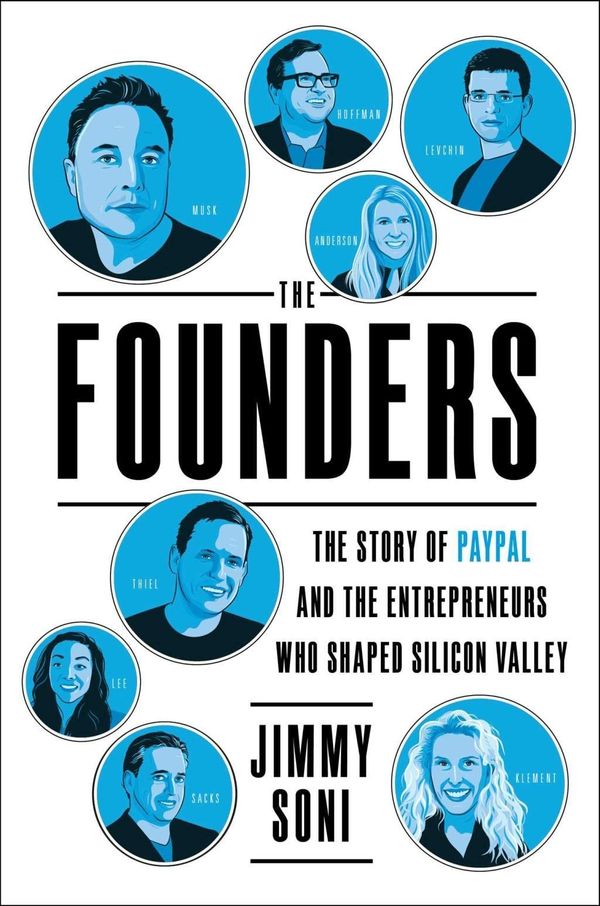
The Founders: The Story of Paypal and the Entrepreneurs Who Shaped Silicon Valley
By Jimmy Soni (2022) Pages: 496, Final verdict: Great-read PayPal's impact transcends the company. I heard this a few times before picking up Soni's latest book, and for good reason. Yes, Paypal is - at the time I'm writing this in May '23... Read more
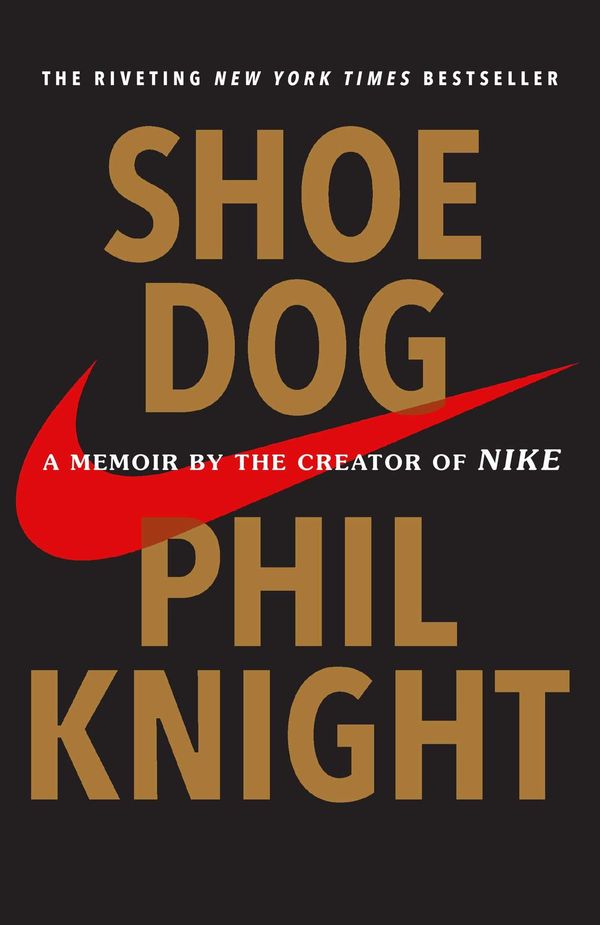
By Phil Knight (2016) Pages: 386, Final verdict: Great-read Where did the biggest athletics company in the world start? Shoe Dog tells the story of Nike, and its humble beginnings in Oregon, United States, through the eyes of its founder and longtime CEO Phil Knight. In fact, Shoe Dog is... Read more
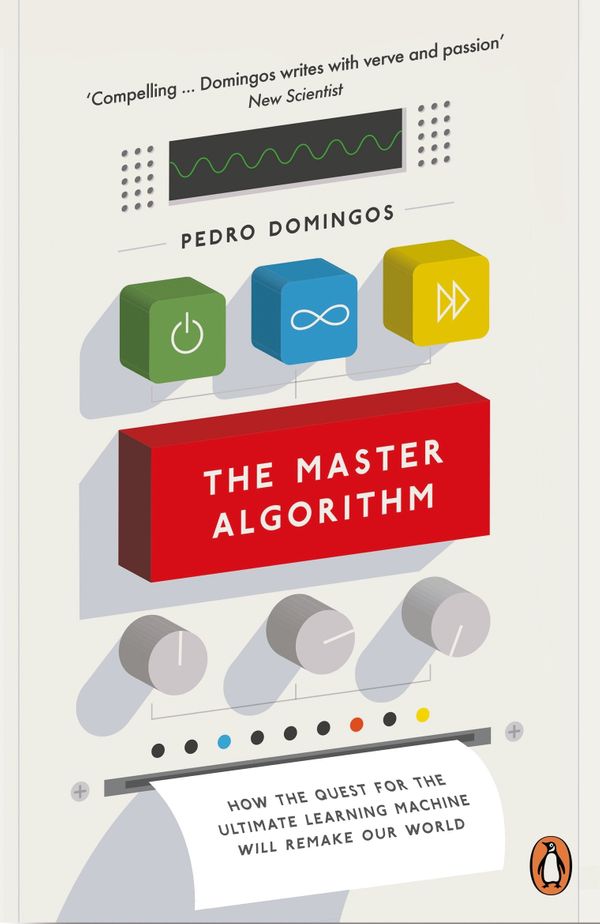
The Master Algorithm
By Pedro Domingos (2015) Pages: 352, Final verdict: Great-read Harvard Business Review declared Data Scientist the sexiest job of the 21st century [https://hbr.org/2012/10/data-scientist-the-sexiest-job-of-the-21st-century], back in 2012. And everywhere you look the words "artificial intelligence", "machine learning" and "algorithms" appear.... Read more

Book Summary: Good to Great by Jim Collins
With over four million copies sold to date, Good to Great by Jim C. Collins is one of the best-selling management books of all time. The follow-up to his international bestseller, Built to Last, Good to Great focuses on how both mediocre and good companies can go beyond their stagnant status-quo to become great organizations.
After studying for an MBA at Stanford, Collins saw first-hand how great companies are run by becoming a consultant at McKinsey & Company, and then a product manager at Hewlett-Packard. After returning to Stanford to teach and conduct research, Collins founded a management research center in Boulder, Colorado, to further his quest for understanding what makes some organizations successful–and others not.
Consequently, the key takeaways from Good to Great are illuminating. The breadth of Collins’ and his research team’s analysis of the good-to-great principles is breathtakingly thorough. This Good to Great review will follow the structure of the book, systematically summarizing the key points from each of the nine chapters, step-by-step.
Post Contents
Good is the Enemy of Great
An overview of the good to great principles, level five leadership, first who…then what, confront the brutal facts – but never lose faith, the hedgehog concept, a culture of discipline, technology accelerators, the flywheel and the doom loop, from good to great to built to last.
Start selling online now with Shopify

The Key Takeaways from Good to Great – a Chapter-by-Chapter Summary
Few people manage to achieve greatness in their lives as they settle too quickly for a comfortable life. The same can be said of companies. Indeed, the vast majority of businesses attain a level of adequate functionality, but instead of progressing beyond this point, they simply stagnate there. With this in mind, Collins asked himself a simple question: Can good companies become great ones, and if yes, then how?
After five years of research, Collins not only certified that a good company can become great, but that any organization can do so – if they follow the framework he suggests. Here’s how both he and his research team began to unpack this question to create the good to great principles:
- The search – Collins assembled a group of researchers, and together, they identified a group of 11 companies out of a possible 1,435 that had spent 15 years at, or below, the general level of the stock market and which then proceeded to go through a transformation which saw them taking in returns of at least three times the stock market level over the next 15 years.
- Finding comparisons – Next, Collins and his team identified a group of “comparison companies.” These included companies that were in the same industries as the good-to-great companies, but that either didn’t leap from good to great or made a short-term shift to great but failed to maintain their success.
- Deep analysis mode – The team collected as much data as possible on each of their 11 companies. They conducted interviews with executives who held positions at the time of their company’s transition. Consequently, the team avoided starting out with any set hypothesis to test. Instead, they sought to build the good to great principles purely from the data, thus directly from the ground up.
- From chaos to concept – From their findings, the team was then able to create a cohesive framework of concepts that each of the good-to-great companies had utilized.
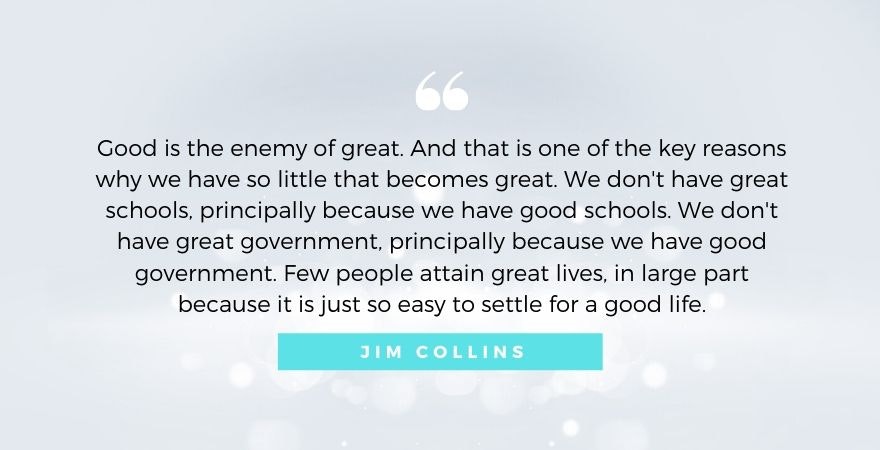
The key factors that decide whether a company can transform from good to great are eight-fold. Each factor is given a chapter in the book, and thus, this Good to Great summary will cover the following points in detail:
- Level five leadership: Surprisingly, the leaders of good-to-great organizations tend to be introverted and reserved rather than big-personality entrepreneurial celebrities.
- First who…then what: Good-to-great companies first get the right people on board before working out the vision of their company.
- Confront the brutal facts but don’t lose faith: A good-to-great company must hold tight to the belief that it can and will prevail against all odds, while also accepting the (often brutal) facts about the company’s current reality.
- The Hedgehog Concept: To go from good to great means that the comfort of complacency must be overcome.
- A culture of discipline: When the workforce is disciplined, hierarchy becomes irrelevant. When there is disciplined thought, bureaucracy is decreased. When there is disciplined control, there is no need for excessive controls. Therefore, when a culture of discipline combines with an entrepreneurial endeavor, great performance is achieved.
- Technology accelerators: Good-to-great companies never use technology as the primary means of integrating change into their processes. However, how they choose to use and select technology is what sets them apart from their comparison companies.
- The flywheel and the doom loop: The good to great process doesn’t happen overnight. Success comes after much-focused attention is applied to moving a company in a single direction over a long period until a point of breakthrough is breached.
- From good to great to built to last: To make sure good-to-great companies endure, core values and purpose must align with something more than just making money.
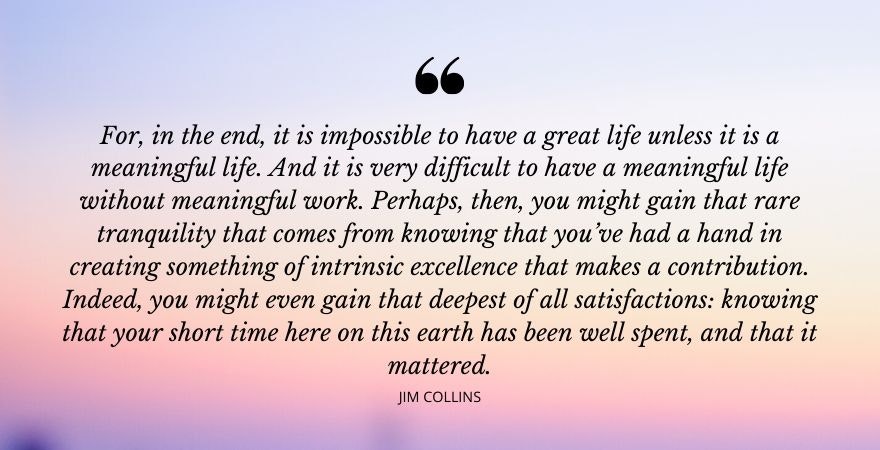
One of the key takeaways from Good to Great is that at the helm of every good-to-great company, there is a “level five leader.” Collins defines a level five leader as an executive who creates an enduring legacy of greatness through a paradoxical blend of humility and professional determination. Such leaders do not let their ego dictate their decisions; their ambition is above all for the success of the company, not for themselves.
At first, Collins found this finding difficult to accept. It went against his belief that a company’s success doesn’t rely solely on its leader. However, the data consistently demonstrates that during the transition from good to great, each great company is led by a level five leader.
This discovery began to make more sense when looking at the sustained success of good-to-great companies. As all of these companies were being overseen by level five managers at the point of their transition, when it came time to hand over the leadership of the company to a new manager, thanks to their humility, and their will to see the company thrive, level five leaders would facilitate a smooth transition for their successors.
What’s startling is that 75 percent of the comparison companies had executives who set up their successors for failure, or who chose weak successors. The egoless actions of the level five leaders, therefore, goes some way to explaining the enduring legacy of good-to-great companies.
However, in addition to humility, level five leaders also have to be in possession of a stoic degree of determination to see the company succeed. An interesting caveat to this essential characteristic is that such loyalty is often cultivated through working for the company before becoming the CEO. Indeed, nearly all of the good-to-great CEOs came from inside the company, whereas the comparison companies were six times more likely to hire CEOs from outside the company.
Level five leaders were also much more likely than the leaders of the comparison companies to attribute any success to factors outside of themselves, and to attribute any shortcomings to themselves (when appropriate). The CEOs of the comparison companies, on the other hand, tend to blame any failings on ‘bad luck’ rather than to accept responsibility, preferring to blame anything beyond themselves.
It’s possible to become a level five leader. However, it comes more naturally to some than others. Self-reflection, personal mentors, teachers, coaches, and learnings from significant life experiences are all tools that can be used in this endeavor. While there is no step-by-step list for how to become a level five manager, practicing the findings from the rest of the book can help cultivate such level five traits, and thus, help us to move in the right direction.
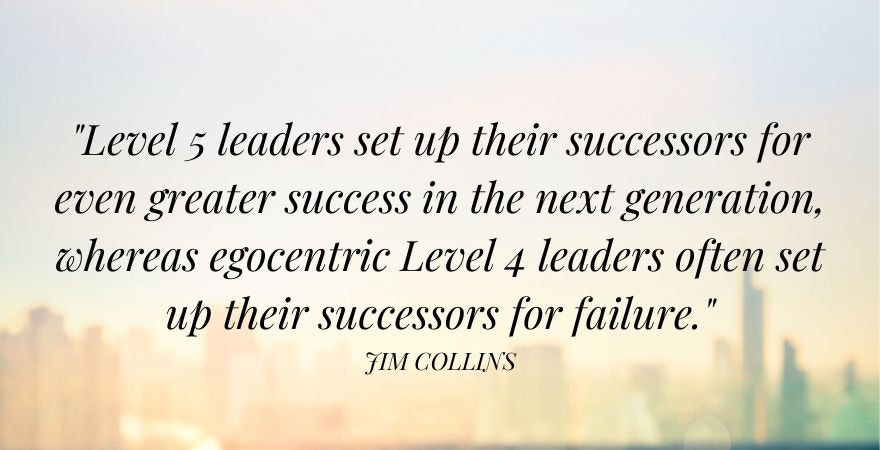
When Collins and his team began their research, they started out thinking that the key to transforming a good company into a great one would be to implement a new vision and strategy. They were wrong. The first thing great companies did was to get the right people involved in the team (and to get rid of any underperforming employees).
This coincides with the idea that if organizations begin with the “who” as opposed to the “what,” they are much more likely to be able to adapt to the ever-shifting demands of the modern world. The right people don’t need to be micromanaged or encouraged to do a good job; it is ingrained within them. They will have faith in the company because they believe in the value of their teammates. Further, if a company comes across a great business idea , but has a poorly functioning team, it is almost certainly doomed to fail.
A particularly intriguing takeaway from Collins’ research is that they found no correlation between executive compensation and the shift from going from good to great. Indeed, the data showed that good-to-great executives made slightly less money, on average, ten years after their company’s transition than their mediocre company counterparts!
It’s important to note that it’s not how much executives are being compensated by, but which executives are being compensated. If companies begin by choosing the “who” before the “what,” these executive members are far more likely to be motivated by the success of the company beyond mere financial compensation.
Still, what to do if once a business is established, some team members don’t seem to match the company standards? The trick is to be rigorous as opposed to ruthless. Collins’ research showed that layoffs occurred five times more frequently in the comparison companies, indicating that endlessly firing swathes of employees is not the best approach. Collins suggests a three-step system for improving a team, without resorting to mass firings:
- When in doubt, don’t hire, keep looking. It is much more costly for a company to hire the wrong person in the long run than to delay the process and find the right person eventually.
- When it does become evident that a group or an individual is a bad match for the company, act quickly, but not before assessing whether that group or individual would be better matched elsewhere within the team.
- Allocate the best team members to the company’s biggest opportunities – not its biggest problems, ensuring that you get the best out of your existing workforce.
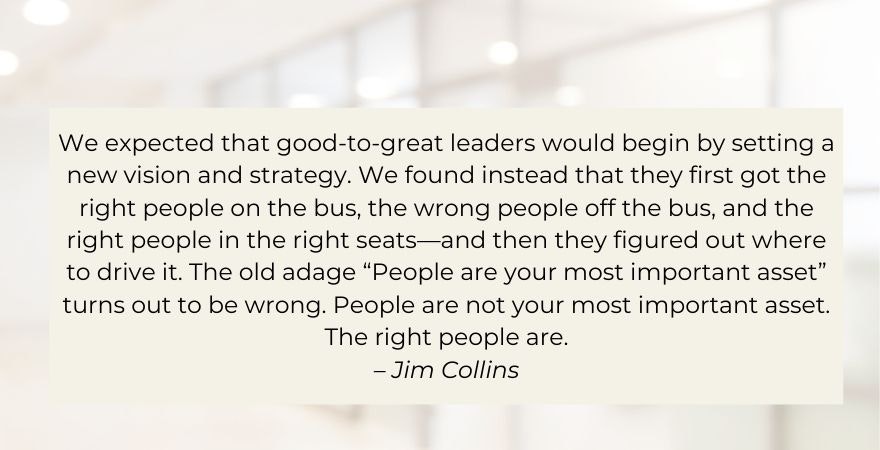
Another key takeaway from Good to Great is that the good-to-great companies pivoted into greatness thanks to a series of excellent decisions which were expertly executed, and which accumulated one on top of the other. This was due, in large part, to how these companies faced the brutal facts about themselves, head-on. Instead of merely setting out for greatness, they continually informed the path to greatness with truths about how they were performing, even if it was hard to swallow.
However, how is it possible to keep a team motivated when faced with such painful truths about the company’s current performance? Collins suggests creating a culture of truth which adheres to the following four principles:
- Lead with questions, not answers. Asking questions is an excellent way of getting a better understanding of the truth. To ask questions also indicates that one is willing to be vulnerable enough to demonstrate that they do not have all of the answers. It’s in this safe environment where reality-based problem solving can occur.
- Engage in dialogue and debate, not correction. Instead of just creating sham debates to make employees feel like they’ve all had their say even if the CEOs have already chosen the course of action, genuinely let a team debate the issues to come up with some more informed solutions.
- Conduct autopsies without blame. In doing so, a culture in which the truth can be heard without fear of backlash can thrive.
- Build “red flag” mechanisms. This mechanism means entitling every member of a workforce to the right to be heard without judgment on any issue that may be concerning them, equipping them with a metaphorical “red flag” that they can raise at any time.
Once a company is prepared to face the truth at every step of their journey, they must somewhat paradoxically, combine this with an unwavering belief in the success of their business . This means that even when things seem desperate, and the reality seems bleak, the team can fall back on this culture of determination to see the company through such difficult phases and, thus, go from good to great.
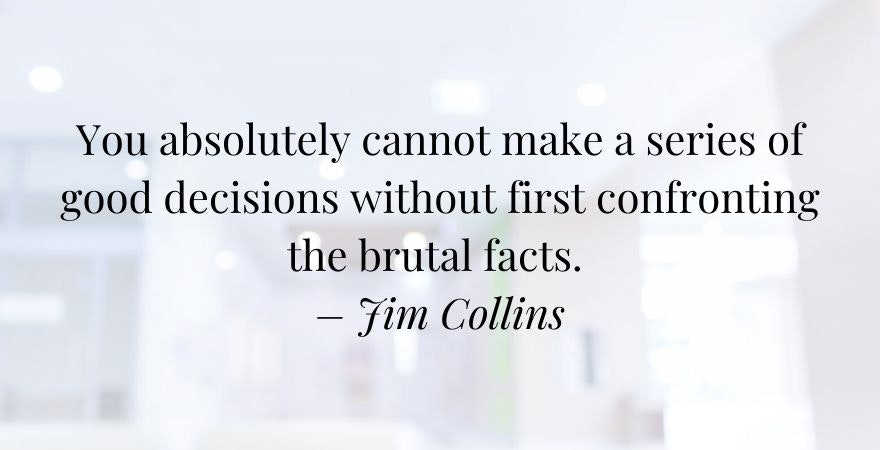
One of the key Good to Great principles is what Collins refers to as “The Hedgehog Concept.” This concept comes from Isaiah Berlin’s essay “The Hedgehog and the Fox,” which is based on an ancient Greek parable and in which he divides the world into two categories: Hedgehogs and foxes. The fox knows a vast variety of different things, but the hedgehog knows one thing, and knows it well. From this logic, many of humanity’s greatest thinkers have been hedgehogs as they have been able to simplify the complexity of the world into a singular unified vision. For example, consider Darwin and natural selection, Einstein and relativity, and Marx and the class struggle.
Collins, therefore, contests that all good-to-great companies were hedgehogs, and all the comparison companies tended to be foxes– scattered, diffused, and inconsistent. The good-to-great companies were all led by a simple, unifying concept that acted as a frame of reference for all of their decision-making. In turn, this led to breakthrough results. Collins breaks down “The Hedgehog Concept,” as being the accumulation of the following three good-to-great principles:
- What you can be the best in the world at. This principle means that even if a company’s core business has been driving relative success for many years, it doesn’t necessarily mean that the company is the best in the world at it. If they are not the best in the world at it, they will never be great. To be great means to transcend the curse of simply being competent. Only by working out what a company can do better than any other organization will lead a company to greatness.
- What drives your economic engine. A company can become great regardless of the industry in which they find themselves. The key is to build a formidable economic engine that is based on deep insights about their economic reality.
- What you are deeply passionate about. Good-to-great companies don’t decide upon an idea and then encourage their team to become excited about it. Instead, they start by only pursuing that which inspires their team members.
When a company can find a unifying concept which links all three of these factors, then that is it’s Hedgehog Concept. More often than not, good-to-great companies started out as not being the best in the world at anything. However, they all, in turn, began the search for their defining Hedgehog Concept, and even though on average it took them four years to find this defining concept, they never wavered from it once they discovered it.
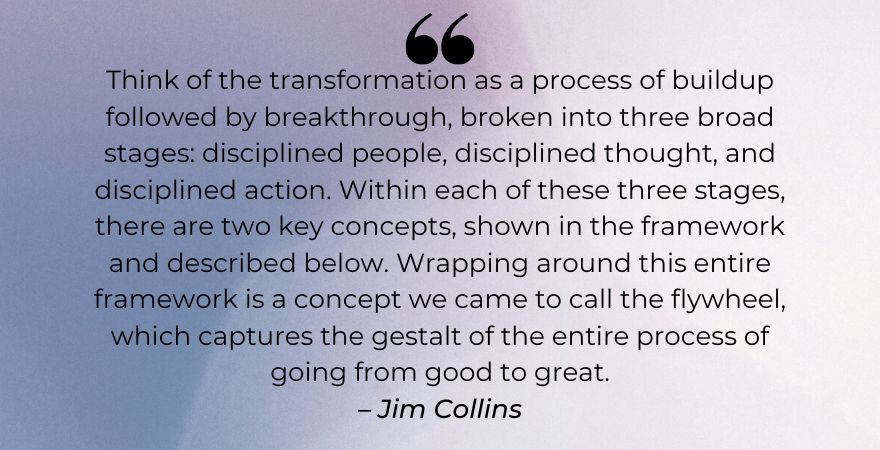
Many successful startups end up failing because, as they become increasingly large and complex, managers begin to flail in the face of increasing demand. It’s at this point that the board may decide to bring in some external “professional” managers, usually experienced MBA executives from blue-chip companies. Hierarchies start to form, and order returns to chaos. However, in this process, entrepreneurial spirit is lost, and mediocrity takes hold, preventing the company from ever becoming great.
So, how does a company manage to maintain an entrepreneurial spirit while also not growing into something entirely unwieldy? By implementing a culture of discipline. Collins suggests a four-step process to encourage a culture of discipline in the workplace:
- Cultivate a culture around the principles of freedom and responsibility that operates within a specific framework.
- Make sure that all employees are self-disciplined individuals willing to go to great lengths to fulfill their responsibilities and obligations.
- Be sure to never conflate a culture of discipline with a culture of tyrannical discipline. Great companies are led by level five leaders who focus on encouraging a culture to form. In contrast, comparison companies are led by leaders who choose to discipline their team via sheer force. This tactic is counterintuitive.
- Religiously follow the Hedgehog Concept to ensure that the entire team remains unwaveringly focused. Indeed, the more that an organization can follow its Hedgehog Concept, the greater the opportunities it will have for growth.
Great companies have lived through incredible technological revolutions such as the .com boom and the advent of the personal computer. But instead of being defeated by such radical advances, they have endured. How? Because rather than panicking and choosing to adapt for adaptation’s sake, they have chosen to think differently about technology. They took the time to consider how such technological advances could best serve their Hedgehog Concept.
Their Hedgehog Concept leads them to a complete change of perspective with regards to technological advancements. Rather than being the creator of momentum, for great companies, technology is an accelerator for momentum. The moment in which a good company pivots into being a great one is never accompanied by a focus on using the most up-to-date, pioneering technology. Technology is only adopted once a company can be sure it will support its aims. Consequently, Collins recommends asking the following questions before selecting a new piece of technology for their organization:
- Does this piece of technology match the Hedgehog Concept?
– If yes, then the company needs to become a pioneer in the application of this technology.
- If no, then is it worthwhile using this technology at all?
– If yes, then the company need not become the world leader in this piece of technology, parity is what you should aim for.
– If no, then the technology is irrelevant.
What separates the great from the good companies is that the good companies become reactionary to new technological advancements. They become terrified of being “left behind” and, therefore, do everything they can to alter their business operations to incorporate the latest pieces of technology, often leading them away from what would otherwise constitute their Hedgehog Concept.
A particularly resounding feature of Collins’ findings is that over the 2,000+ pages of interview transcripts with executives from their chosen great companies, the term “competitive strategy” is hardly mentioned at all. Instead, rather than worrying about what their competitors are doing and getting caught up in a redundant technological arms race, great companies compared themselves to an ideal of excellence. They are motivated by excellence for its own sake, not from a fear of being left behind.
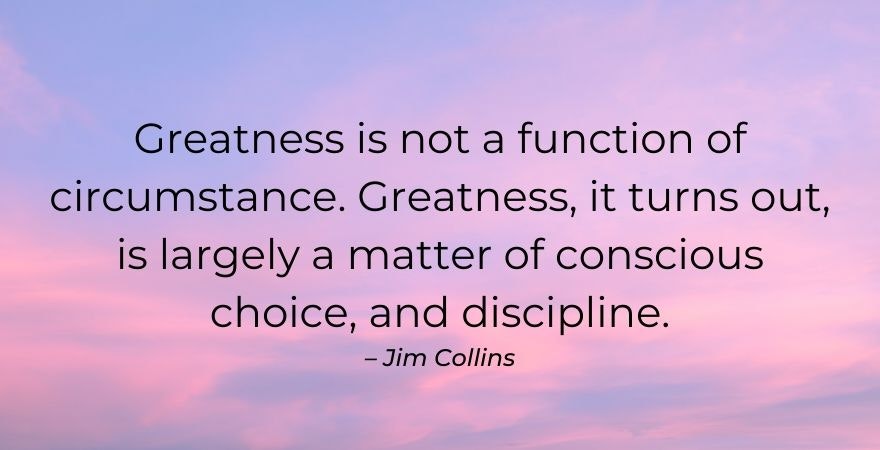
For this good to great principle, Collins conjures up the image of an individual trying to move a considerable, 5,000-pound metal disc (a flywheel), which is mounted horizontally on an axle. At first, it seems impossible to push. After a bit of momentum is generated, it becomes easier to rotate, after many rotations, it flies forward with an almost unstoppable force. To ask which of the pushes the flywheel was given was the deciding push that gave it such speed is to miss the point; it was the accumulation of all of the efforts combined that got the wheel moving. This image is what a company looks like when it is making the transition from good to great.
From the outside, it often appeared as though these good-to-great companies miraculously made their ascent to greatness overnight, as if one deciding factor changed their fortunes forever. However, from the inside, the transformation was experienced as a much more organic, gradual, developmental process. Fascinatingly, many executives at these great companies stated that they were unaware that such a major transformation was afoot, even when their company was well on its way to greatness.
What separates the great companies from the good is, therefore, the understanding of a simple truth: Remarkable power is to be found in continual improvement and the delivery of results. Collins refers to this as the “flywheel effect,” which is defined by the following continually repeating processes:
- Make forward steps that are consistent with the Hedgehog Concept.
- Accumulate a set of visible results.
- See the workforce become energized and excited by these results.
- The flywheel builds momentum. Repeat from step one.
By continually feeding the flywheel through following the above steps, goals almost seem to set themselves. The comparison companies, on the other hand, often engaged in what Collins refers to as “the doom loop.” Rather than focusing on gradual, sustained results, the comparison companies would frequently search for a “miracle moment,” which would be the singular deciding factor in transforming the company from good to great.
By bypassing the incremental development phase, they would start pushing the flywheel in one direction only to stop and change course, throwing it into another direction as they looked for another “miracle moment,” therefore, failing to build any momentum at all. Collins describes the steps of the doom loop as follows:
- Set out in a new direction, looking for a “miracle moment” by way of a new program, leader, event, fad, or acquisition.
- Fail to achieve any buildup and accrue no accumulated momentum.
- Achieve some disheartening results.
- React without actually understanding the reasons behind the results. Repeat from step one.
The biggest takeaway from the flywheel effect and the doom loop is that sustainable transformations follow a prolonged period of buildup before a lasting breakthrough can take place. There are no quick fixes, and just like the adage goes, good things come to those who wait (and who vigorously pursue their Hedgehog Concept!).
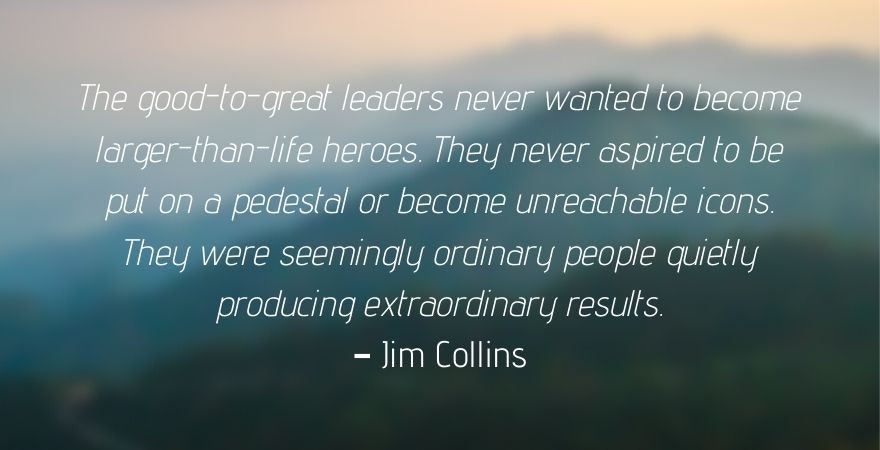
Before he wrote Good to Great, Collins spent six years researching and compiling his other bestselling book, Built to Last. This book dealt with the central question: What does it take to build an enduring company from the ground up? While it was universally acclaimed, Collins acknowledges that it failed to answer how to transform an already good company into a great one – this is why he decided to write Good to Great.
Consequently, Collins views Good to Great as a prequel to Built to Last; applying the findings from Good to Great can help to create a great startup or an established organization, and then the findings from Built to Last can make sure the company’s legacy endures. Where Good to Great lays the groundwork for getting the flywheel turning, Built to Last focuses on how to keep the wheel turning for many years to come.
Collins briefly summarizes the key takeaways from Built to Last as follows:
- Clock building, not time telling – Build a company that can endure through multiple product life cycles and leaders. By doing this, you ensure that a company is not built around a single charismatic individual or a static, singular product idea.
- The genius of AND – When deciding between two extremes, see if you can incorporate both into your working processes. I.e., Instead of choosing between A or B, find a way to have both A AND B, thus, purpose AND profit, freedom AND responsibility, etc.
- Core ideology – A great, lasting organization will have core values and a core purpose that goes beyond just making money as its means for informing decision making.
- Preserve the core/stimulate progress – While making sure to persevere with the core values, also make room for change and innovation.
Ultimately, Collins believes that by following the findings of these two books, that building a great company is no more difficult than building a good one. That is because a lot of the work that goes into creating a good company is wasted effort, an effort that could otherwise be better spent getting closer to aligning all organizational processes to adhere to a singular Hedgehog Concept.
From here, Collins extrapolates that when all the pieces begin to come together, and a company goes from good to great, this has a ripple-out effect in the lives of all those involved. It imbues their lives with a deep sense of meaning because they are engaged in a meaningful project aimed at an ideal of excellence in and of itself.
You can buy Good to Great by Jim C. Collins on Amazon .

15 Best Screen Recording Software Programs in 2024
Whether you want to create a product tutorial or capture gameplay footage, a high-quality screen recording software wil…

Social Media Engagement: 9 Ways to Amplify Your Audience Connection
Learn what social media engagement is and how you can improve yours to drive greater awareness of your business.

15 Top Print-On-Demand Companies (And How To Choose One) in 2024
There are so many print-on-demand companies to choose from — what do you need to consider to choose the best one for yo…
Oberlo uses cookies to provide necessary site functionality and improve your experience. By using our website, you agree to our privacy policy.
‘Good to Great’ book review
I have just finished Good to Great by Jim Collins and I wanted to record my reflections about the book. However, I am in somewhat of a dilemma. On the one hand, I really enjoyed the book and felt that many of the concepts Jim talks about are values and ideas that I recognise as important in building a great business. On the other, I have read a number of critical reviews of the book (such as that by Rob May ) pulling apart both the fundamental research foundations of the book and also its findings.
Overall, I think that Good to Great provides a very useful model and framework for developing and creating a great business. Concepts such as the flywheel go some way to challenging the ‘magic bullet’ fascination within the business world. Similarly, a Level 5 leader in place of ‘Fred the Shred’ might have created a very different outcome for Royal Bank of Scotland in the last year.
Solving the impossible
At the same time, trying to unravel the complexity of the business world to create a model that enables a business to become great is a tall order! Businesses operate in too complex an environment for a ‘key to business success’ to exist. Any business book that claims to have discovered the ‘secret to success’ is deceiving itself. Although I don’t feel that Jim Collins does claim the key to success in Good to Great , the book is taking on a huge task in assessing what creates ‘greatness’ and I suppose it is not surprising if it falls a little short of the answers.
Everlasting greatness
Obviously, there are other criticisms leveled against the book regarding the companies that were chosen and their subsequent fall from grace – Fannie Mae, being the most recent. However, the book never claims that the companies chosen will continue to be great beyond the 15 years of great performance shown. Indeed, 4 of the 11 great companies used in the study were facing serious challenges to their greatness or had already lost it by the time the book was published. It is also worth noting that Jim has recently published a new book (although I haven’t yet had chance to read it), entitled ‘ How the mighty fall: And why some companies never give in ‘, which I imagine begins to examine some of the questions raised by the fall of great companies.
Correlation versus Causality
I think one of the key problems with many studies and books is that of causality and correlation. Causality and correlation are similar and yet entirely different. Causality is where one or more factors cause an effect; correlation is where a relationship of some kind exists between two factors but one is not necessarily the cause of the other. Yet, so often when correlation is discovered, people assume they have discovered causality. Good to Great discovers correlation, but cannot prove causality: there are too many other uncontrollable and unexaminable factors to pin down exactly what causes greatness.
Should you read it?
If you are looking for factors (or levers) within a business that can be proven beyond doubt to create success then you might as well stop reading business books!
If however, you are looking for interesting ideas that help develop you and your business, not as a magic formula but rather as concepts to play against and spark off, then Jim Collins’ Good to Great does just that. It may not hold the secrets to success but it will certainly provide you with food for thought!

Matt Stocker
Matt is founder and director of Stocker Partnership, a strategy and innovation consultancy. As a strategist, designer, innovator and geek, he's known for his creative thinking. Matt thrives in challenging environments and loves to push the boundaries of possibility. He's a big picture, visual thinker who is always running 5 to 10 years ahead. More about us

Related Content
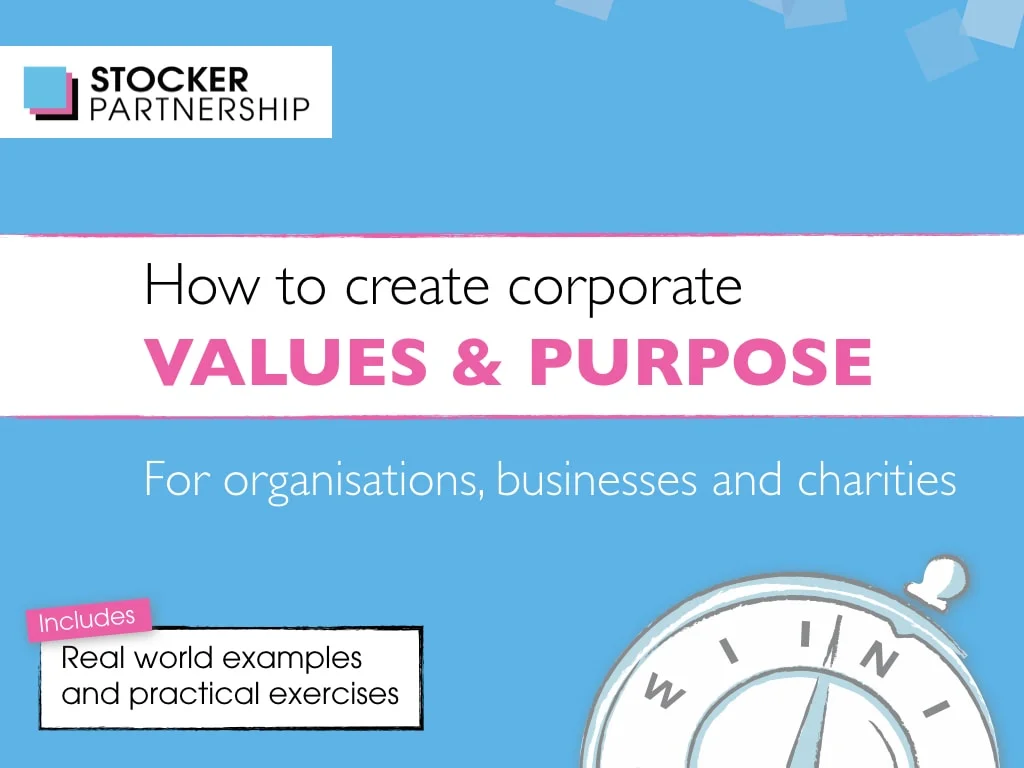
How to create corporate values and purpose

Our exciting and unusual news this Christmas

WaterAid is certainly big, hairy and audacious!

Breeding success—a failure how to

Four approaches to creating a BHAG—what’s yours?
Share article, get in touch.
+44 (0)24 76 100 193

The Best Books of the Year (So Far)
The nonfiction and novels we can’t stop thinking about.
Supported by
- Share full article
By The New York Times Books Staff
- May 24, 2024
Fiction | Nonfiction
We’re almost halfway through 2024 and we at The Book Review have already written about hundreds of books. Some of those titles are good. Some are very good. And then there are the following.
We suspect that some (though certainly not all) will be top of mind when we publish our end-of-year, best-of lists. For more thoughts on what to read next, head to our book recommendation page .

James , by Percival Everett
In this reworking of the “Adventures of Huckleberry Finn,” Jim, the enslaved man who accompanies Huck down the Mississippi River, is the narrator, and he recounts the classic tale in a language that is his own, with surprising details that reveal a far more resourceful, cunning and powerful character than we knew.
Local bookstores | Barnes and Noble | Amazon
Good Material , by Dolly Alderton
Alderton’s novel, about a 35-year-old struggling to make sense of a breakup, delivers the most delightful aspects of romantic comedy — snappy dialogue, realistic relationship dynamics, funny meet-cutes and misunderstandings — and leaves behind clichéd gender roles and the traditional marriage plot.
Martyr! , by Kaveh Akbar
A young Iranian American aspiring poet and recovering addict grieves his parents’ deaths while fantasizing about his own in Akbar’s remarkable first novel, which, haunted by death, also teems with life — in the inventive beauty of its sentences, the vividness of its characters and the surprising twists of its plot.
The Hunter , by Tana French
For Tana French fans, every one of the thriller writer’s twisty, ingenious books is an event. This one, a sequel to “The Searcher,” once again sees the retired Chicago cop Cal Hooper, a perennial outsider in the Irish west-country hamlet of Ardnakelty, caught up in the crimes — seen and unseen — that eat at the seemingly picturesque village.
Wandering Stars , by Tommy Orange
This follow-up to Orange’s debut, “There There,” is part prequel and part sequel; it trails the young survivor of a 19th-century massacre of Native Americans, chronicling not just his harsh fate but those of his descendants. In its second half, the novel enters 21st-century Oakland, following the family in the aftermath of a shooting.
Headshot , by Rita Bullwinkel
Set at a women’s boxing tournament in Reno, Nev., this novel centers on eight contestants, and the fights — physical and emotional — they bring to the ring. As our critic wrote: This story’s impact “lasts a long time, like a sharp fist to your shoulder.”
Beautyland , by Marie-Helene Bertino
In 1970s Philadelphia, an alien girl sent to Earth before she’s born communicates with her fellow life-forms via fax as she helps gather intel about whether our planet is habitable. This funny-sad novel follows the girl and her single mother as they find the means to persevere.
Knife: Meditations After an Attempted Murder , by Salman Rushdie
In his candid, plain-spoken and gripping new memoir, Rushdie recalls the attempted assassination he survived in 2022 during a presentation about keeping the world’s writers safe from harm. His attacker had piranhic energy. He also had a knife. Rushdie lost an eye, but he has slowly recovered thanks to the attentive care of doctors and the wife he celebrates here.
Everyone Who Is Gone Is Here: The United States, Central America, and the Making of a Crisis , by Jonathan Blitzer
This urgent and propulsive account of Latin American politics and immigration makes a persuasive case for a direct line from U.S. foreign policy in Central America to the current migrant crisis.
The Wide Wide Sea: Imperial Ambition, First Contact and the Fateful Final Voyage of Captain James Cook , by Hampton Sides
By the time he made his third Pacific voyage, the British explorer James Cook had maybe begun to lose it a little. The scientific aims of his first two trips had shifted into something darker. According to our reviewer, the historian Hampton Sides “isn’t just interested in retelling an adventure tale. He also wants to present it from a 21st-century point of view. ‘The Wide Wide Sea’ fits neatly into a growing genre that includes David Grann’s ‘ The Wager ’ and Candice Millard’s ‘ River of the Gods ,’ in which famous expeditions, once told as swashbuckling stories of adventure, are recast within the tragic history of colonialism .”
The Rebel’s Clinic: The Revolutionary Lives of Frantz Fanon , by Adam Shatz
This absorbing biography of the Black psychiatrist, writer and revolutionary Frantz Fanon highlights a side of him that’s often eclipsed by his image as a zealous partisan — that of the caring doctor, who ran a secret clinic for Algerian rebels.
Fi: A Memoir , by Alexandra Fuller
In her fifth memoir, Fuller describes the sudden death of her 21-year-old son. Devastating as this elegant and honest account may be — it’s certainly not for the faint of heart — it also leaves the reader with a sense of having known a lovely and lively young man.
Explore More in Books
Want to know about the best books to read and the latest news start here..
An assault led to Chanel Miller’s best seller, “Know My Name,” but she had wanted to write children’s books since the second grade. She’s done that now with “Magnolia Wu Unfolds It All.”
When Reese Witherspoon is making selections for her book club , she wants books by women, with women at the center of the action who save themselves.
The Nobel Prize-winning author Alice Munro, who died on May 14 , specialized in exacting short stories that were novelistic in scope , spanning decades with intimacy and precision.
“The Light Eaters,” a new book by Zoë Schlanger, looks at how plants sense the world and the agency they have in their own lives.
Each week, top authors and critics join the Book Review’s podcast to talk about the latest news in the literary world. Listen here .
Advertisement
Common Sense Media
Movie & TV reviews for parents
- For Parents
- For Educators
- Our Work and Impact
Or browse by category:
- Get the app
- Movie Reviews
- Best Movie Lists
- Best Movies on Netflix, Disney+, and More
Common Sense Selections for Movies

50 Modern Movies All Kids Should Watch Before They're 12

- Best TV Lists
- Best TV Shows on Netflix, Disney+, and More
- Common Sense Selections for TV
- Video Reviews of TV Shows

Best Kids' Shows on Disney+

Best Kids' TV Shows on Netflix
- Book Reviews
- Best Book Lists
- Common Sense Selections for Books

8 Tips for Getting Kids Hooked on Books

50 Books All Kids Should Read Before They're 12
- Game Reviews
- Best Game Lists
Common Sense Selections for Games
- Video Reviews of Games

Nintendo Switch Games for Family Fun

- Podcast Reviews
- Best Podcast Lists
Common Sense Selections for Podcasts

Parents' Guide to Podcasts

- App Reviews
- Best App Lists

Social Networking for Teens

Gun-Free Action Game Apps

Reviews for AI Apps and Tools
- YouTube Channel Reviews
- YouTube Kids Channels by Topic

Parents' Ultimate Guide to YouTube Kids

YouTube Kids Channels for Gamers
- Preschoolers (2-4)
- Little Kids (5-7)
- Big Kids (8-9)
- Pre-Teens (10-12)
- Teens (13+)
- Screen Time
- Social Media
- Online Safety
- Identity and Community

Real-Life Heroes on YouTube for Tweens and Teens
- Family Tech Planners
- Digital Skills
- All Articles
- Latino Culture
- Black Voices
- Asian Stories
- Native Narratives
- LGBTQ+ Pride
- Best of Diverse Representation List

Celebrating Black History Month

Movies and TV Shows with Arab Leads

Celebrate Hip-Hop's 50th Anniversary
Ratings and reviews parents trust.

The Garfield Movie
Legendary cat's animated adventure has peril, lots of ads.

Poignant fantasy about loss and the power of imagination.

Sex, nudity, smoking in sumptuous, diverse period drama.

Maxton Hall: The World Between Us
Indulgent romp doesn't skimp on shirtless boys, drinking.

Our Editors Recommend

Movies & TV That Applaud Asian, Asian American, Native Hawaiian, and Pacific Islander Heroes & Competitors
Inspire your family with these stories of bravery and persistence.

Stories Set in Asia and the Pacific Islands
Explore the many countries and cultures that call Asia and the Pacific home.

Bollywood Movies
Discover some of the best of Bollywood with these movies.

Common Sense Selections

Robot Dreams

Jurassic World: Chaos Theory

Secrets of the Octopus

Stax: Soulsville U.S.A.
Popular with parents.

52 parent reviews
"Best kids movie I’ve seen in years."
6 parent reviews

The Fall Guy
11 parent reviews
29 parent reviews

Know you're making the best possible choices for your kids.
Since 2003, Common Sense has been the leading independent source for media recommendations and advice for families.
Wherever your family likes to stream or shop, we're here for you.
Look for us next time you're searching for something to watch, read, or play.

Not-for-profit partnerships, generous foundation support, and contributions from parents like you keep Common Sense free and available to families everywhere.
'ZDNET Recommends': What exactly does it mean?
ZDNET's recommendations are based on many hours of testing, research, and comparison shopping. We gather data from the best available sources, including vendor and retailer listings as well as other relevant and independent reviews sites. And we pore over customer reviews to find out what matters to real people who already own and use the products and services we’re assessing.
When you click through from our site to a retailer and buy a product or service, we may earn affiliate commissions. This helps support our work, but does not affect what we cover or how, and it does not affect the price you pay. Neither ZDNET nor the author are compensated for these independent reviews. Indeed, we follow strict guidelines that ensure our editorial content is never influenced by advertisers.
ZDNET's editorial team writes on behalf of you, our reader. Our goal is to deliver the most accurate information and the most knowledgeable advice possible in order to help you make smarter buying decisions on tech gear and a wide array of products and services. Our editors thoroughly review and fact-check every article to ensure that our content meets the highest standards. If we have made an error or published misleading information, we will correct or clarify the article. If you see inaccuracies in our content, please report the mistake via this form .
The 15-inch MacBook Air dropped $300 at Best Buy this Memorial Day

What's the deal?
Right now, Best Buy is selling the 15-inch MacBook Air (M2) for $300 off , whether you opt for the 256GB or 512GB variant.
ZDNET's key takeaways
- Apple's 15-inch MacBook Air with M2 is no longer the latest ultraportable from the company, but it's still a formidable laptop one year later.
- The larger screen and lighter form factor make it a compelling device for content creators, designers, and more.
- Still, the absence of extra ports is felt, with just two USB-C and one 3.5mm headphone jack available on the laptop.
For the longest time, Apple's MacBook lineup was in a bit of disarray. Choosing the right model primarily boiled down to budget and display preference, but if you wanted a larger screen, you'd have to pay up for a Pro model, even if the extra power and ports were unnecessary. For most user applications, it's overkill.
Also: M3 MacBook Air (2024) review: Benchmark results of Apple's AI laptop may surprise you
That's why the 15-inch MacBook Air changes everything and has made my job so much easier. Apple's large-screen MacBook is ultraportable, will satisfy anyone's content-consuming heart, and somehow costs just $100 more than its smaller, older predecessor .
While the M2 model featured in this article is no longer the newest offering from Apple -- there's now an M3 variant in town -- it looks nearly identical to its successor, has the same 18-hour battery life rating, and is only missing two features (dual-monitor support and Wi-Fi 6E), chipsets aside. That said, for less money, the M2 MacBook Air may still be the best laptop for you. Here's why.
To keep it simple, besides the larger chassis and some upgrades under the hood, the 15-inch MacBook Air is the same system as 2022's 13-inch model. We named the latter ZDNET's Product of the Year for its competency, portability, and price, and you're getting the same value propositions this time around.
Also: MacBook Air vs MacBook Pro: How to decide which model to buy
The design of the MacBook is sleek and modern, with elements like flat edges, the camera notch, and MagSafe charging that have trickled down from Apple's higher-end laptops. What wasn't carried over was the extra ports and slots for HDMI and SD cards. (You won't get those aspects on the new M3 model either.)
Comparing the port selection between the 15-inch MacBook Air (left) and the 16-inch MacBook Pro (right).
I get it: This is a MacBook Air, not a MacBook Pro. But something just feels off about having more real estate yet the same amount of ports as the previous, smaller model. For reference, the count is two left-aligned USB-C ports and a 3.5mm headphone jack on the right. An additional USB-C on the right side is all I really ask for. That way, charging the MacBook doesn't always feel like a game of tug-of-war with my outlet.
The MagSafe charging port, along with the only two USB-C ports, is found on the left side of the laptop.
My review unit came in Starlight, which shimmers in gold and silver hues and doesn't retain fingerprints like the FBI agent that is the Midnight variant. Altogether, this is one of the better-looking 15-inch laptops I've used and is a testament to Apple's maturity when it comes to the MacBook's industrial design.
While the 15-inch MacBook Air is relatively lightweight (2.7 pounds) compared to other big-screen laptops, I wouldn't go as far as to say that it's unnoticeable when tucked in a backpack. That was the case with the 13-inch Air that I lugged around at CES, but not with this model.
Still, it's a nice middle ground and induces less back pain than the 16-inch MacBook Pro typically found in my everyday carry. I have no problem recommending this to students, hybrid workers, and coffee shop dwellers, which I don't often say about 15-inch laptops.
The 15-inch MacBook Air still has a backlit keyboard with function keys. And the trackpad is larger than ever.
To round out the design differences, the 15-inch MacBook Air features a six-speaker sound system compared to last year's four-speaker. Audio still fires up from the keyboard, not the sides, but the upgrade is definitely noticeable. Instead of having to crank up the MacBook's volume to the max, which I often found myself doing with the 13-inch when watching movies or playing music in the kitchen, the 15-inch at 75% volume is adequate.
Also: The best MacBook accessories of 2024: Expert tested and reviewed
If we want to get into the nitty-gritty, I still prefer the fuller, more bass-heavy audio produced by the MacBook Pro's speakers, but for a $600-$800 price gap, I can live with the MacBook Air's version.
As far as day-to-day performance goes, the MacBook Air, powered by an M2 chip, 8-core CPU, and now 10-core GPU by default, handled my usual spectrum of multi-window browsing, conference calls, photo and video editing, and constant media streaming gracefully. The lack of cooling fans means the Air is near-silent, even when it's cranking out graphics and uploading/downloading large video files.
The MacBook Air's display ramps up to 500 nits of brightness, which is just enough in most well-lit environments.
The laptop is capable of 4K exports on Adobe Premiere Pro and editing RAW files on Adobe Photoshop, but anything more intense, such as 3D modeling and animating, will likely push the Air to its limit. At that point, the MacBook Pro , Mac Studio , and Mac Pro has your name on it. Or, the M3-powered MacBook Air may be more suitable for your needs.
Also: How Apple's chip transition yielded such an oddly configured Mac Pro
What I found myself missing when testing the MacBook Air was the 120Hz ProMotion display from the Pro line. All it took was an hour or two before my eyes adapted to the slower, less smooth 60Hz panel, but the larger 15-inch display didn't make the transition easy. In fact, it made the difference more apparent.
ZDNET's buying advice
All that is to say, the 15-inch MacBook Air faces the same criticisms as the older 13-inch model , like the lack of utility ports and a slower refresh rate display. And for those reasons, it's not the laptop for me.
But everything else about it is as good as the $1,299 price point gets. My parents, who favor the larger, more vivid viewing experience, will love it. My partner, a teacher who spends hours a day sifting through spreadsheets, will love it. And my younger cousin, an undergraduate who's always on his feet and writing research papers, will love it. This is the MacBook most people have been waiting for and is the one that most people should buy.
Featured reviews
Macbook pro (m3 max) review: apple's pro ai laptop is a chart-topper in 2024, dell xps 16 (2024) review: this windows laptop gives the macbook pro a run for its money, the best apple deals you can buy this month: iphones, apple watches, ipads, and more.
Lenovo Yoga Book 9i (2024) review: A dual-screen laptop that changes how I work
If you're not using two screens, how do you even computer?
After reviewing the first generation of the Yoga Book 9i a year ago, I was pumped when Lenovo announced a refresh at CES. The product was flawed in certain ways, but it's so good. Who knew a dual-screen laptop could end up being so practical?
The Lenovo Yoga Book 9i (2024) is, more or less, the same as its predecessor. It includes Intel's new Core Ultra processors and a Copilot key on the keyboard, but that's all that's different. Moreover, it's using U-series processors, so it doesn't pack the same performance improvement that we're seeing on a lot of other laptops, like the Yoga 9i (2024).
I sure love this form factor though. Using the Yoga Book 9i really gives me a dual-monitor feel, making life a whole lot easier. I used to carry a portable monitor when I travel. With the Yoga Book, it's really all I need.
Lenovo Yoga Book 9i review: It's shockingly good
Lenovo sent XDA the Yoga Book 9i (2024) for review. It did not have any input on the contents of this article.
Yoga Book 9i (2024)
With a Core Ultra CPU, up to 32GB of RAM, up to 1TB of storage, and an OLED display, this convertible, dual-screen laptop from Lenovo is a capable, premium machine. If you're ready for a new kind of laptop computing experience, this PC is more than worth considering.
- The dual-screen laptop form factor is game-changing
- The soundbar offers best-in-class audio quality
- Keyboard quality feels like a proper laptop
- Apps still open underneath the keyboard
- Laptop mode is still awkward with touchscreen trackpad
- Stand and keyboard storage isn't easy
Lenovo Yoga Book 9i (2024) price and availability
The Lenovo Yoga Book 9i (2024) is available now, and it starts at $1,980, just a touch less than the previous model started at. That gets you an Intel Core Ultra 7 155U, 16GB RAM, and a 512GB SSD. You can upgrade from there.
The price tag is one of the selling points of the Yoga Book 9i, compared to $5,000 foldables like the HP Spectre Foldable. This is priced more like a premium laptop, and while it's still not cheap by any means, it's within reach if this is the kind of experience that you want.
HP Spectre Foldable review: Finally, a great foldable PC
Specifications, the dual-screen life, you get two monitors everywhere you go.
There are two ways that you can use both screens of the Yoga Book 9i. One is with the two screens side-by-side, and one is with one screen on top of the other. It fits on the stand either way, and there are benefits to both. You can use it like that in clamshell mode as well, but I can't imagine how that would be practical.
If you use dual monitors at home, you already know how this can affect your work flow. For me personally, I like to have a browser on one screen that I'm working in, and a second screen for everything else, whether it's Slack, OneNote, or anything I'm not constantly looking at. Being used to two 27-inch 4K monitors at home, it's surprising that two 13.3-inch screens can be so good.
If you use dual monitors at home, you already know how useful this is.
I'm also more inclined to use the two screens on top of each other. When they're side-by-side, both screens are in portrait orientation, so you have to be comfortable with that.
The other problem with that is webcam placement. When they're like that, the webcam is on the side, and that's in portrait orientation too. However, when one screen is on top of the other, the webcam is perfectly placed in front of my face. It's a fantastic experience for calls. I have Google Meet open on the top screen and OneNote open on the bottom one.
Of course, if you're using both screens, you need both a keyboard and a mouse, which come with the product. The keyboard is Bluetooth, so you can put it anywhere.
But one of my biggest issues with the keyboard is that it doesn't have a trackpad into it. The pieces that you have to carry alongside of the laptop itself really start to add up, including the stand, the keyboard, the pen, and a mouse. On top of that, there's no neat way to store and of it. The keyboard folds inside of the stand, but it doesn't attach to the laptop lid in any proper way.
Obviously, the Yoga Book 9i folds flat, so none of those accessories will fit inside of it.
Still, I can't stress enough how great it is to have two screens on a laptop. Carrying everything around is a pain, but it's worth it when you're working out of a hotel room.
Using it as a laptop
It gets a little dicey.
The Bluetooth keyboard magnetically attached to the bottom screen so you can use it as a laptop. If you don't feel like carrying the keyboard, you can use the onscreen touch keyboard if you like. I wouldn't write articles like that though.
Unfortunately, I really don't like using the touchscreen trackpad any better than the keyboard. You can use a mouse of course, but as far as laptop touchpads go, this is not a good one. Below the trackpad area, there are two onscreen buttons that you're meant to press when you want to click, and they work well enough. It just always feels like it's too sensitive. You do get the option to have the trackpad span the width of the screen, which is pretty neat.
There's another big problem. The area under the Bluetooth keyboard doesn't get turned off, so you can drag the pointer down there. Indeed, if you can't find it, that's probably where it is. Apps open down there sometimes as well. Good luck finding those.
These were all issues with the first-gen model, and I was really hoping to see some improvement with this one. In fact, that was what I was hoping for more than any potential performance improvements we might get from Core Ultra U.
It has the best keyboard for a device with this type of form factor.
Earlier this year, Asus released the Zenbook Duo, its own dual-screen laptop. It starts at $1,500 and it doesn't have these issues. The bottom screen gets shut off when the keyboard is attached because the keyboard has its own trackpad. That screen doesn't have to be powered on to provide that experience.
Asus Zenbook Duo (2024) review: Proving that dual-screen laptops aren’t a gimmick
Ultimately, I do really like using the Yoga Book 9i in clamshell mode, with the keyboard and a mouse. The keyboard is excellent. For something so compact, it's hard to find anything that has the quality of a proper laptop keyboard. And keyboards are something that Lenovo laptops are definitely good at.
This is a great product, but honestly, I'm just frustrated that Lenovo didn't fix the glaring issues with last year's model. I remember when Asus launched the Zenbook Duo and all of us asked the same question, which was if it had the same issues as the Yoga Book 9i.
Performance
Core ultra u isn't the upgrade i was hoping for.
It's rarely worth talking about gen-over-gen upgrades when it comes to laptops. I don't think anyone is considering an upgrade every year like they might do with a phone. I feel like it has to be mentioned here because frankly, this feels like the same product.
Prior to this, every Core Ultra laptop I've tested has been H-series, an upgrade that most premium laptops received this generation. When it comes to single-core performance, it's a downgrade from 13th-gen, and U-series comes in at a lower wattage than that. Graphics in U-series aren't as much of an upgrade as H-series, although like any decent laptop, it supports multiple external displays, so you can get even more screens on this thing.
The big feature for Core Ultra is the Neural Processing Unit (NPU). The only problem is that you can't really do anything. For whatever reason, this laptop doesn't even support Windows Studio Effects, which lets you do things like blur your background on-device.
Moreover, chips like the Snapdragon X Elite and Intel's Lunar Lake family are almost here. When those launch, Meteor Lake laptops like this one won't even be considered "AI PCs".
So with that in mind, Meteor Lake U feels a lot like 13th-gen U.
The benchmarks show no meaningful changes gen-over-gen, although as promised, graphics are improved. I also added the HP Spectre x360 14 for comparison, because most premium laptops are getting bumped up to the H-series, so you can see the difference between the two.
On average, I got just under seven hours of battery life, which is pretty solid. Note that I test battery life with real-world usage, rather than using a battery benchmark that doesn't mimic how anyone would use their computer. Also, battery life doesn't change between whether you're using both screens or if you're using it as a laptop with the keyboard attached. Both screens are powered on at all times.
Should you buy the Lenovo Yoga Book 9i (2024)?
You should buy the Lenovo Yoga Book 9i (2024) if:
- You use dual monitors at home
- You want a laptop, but something that's a little different
- You plan on streaming movies or music
You should NOT buy the Lenovo Yoga Book 9i (2024) if:
- You don't want to carry around extra gear
- You're editing photos or video
- $2,000 is just out of your price range
The Lenovo Yoga Book 9i is one of my favorite laptops on the market , despite its shortcomings. My biggest complaint is that the 2024 model feels exactly like the 2023 one. There doesn't seem to be a performance boost from Core Ultra U, and the software issues everyone complained about last time haven't been fixed; however, the landscape has changed. Asus has entered the market with a product that doesn't have those issues, and costs 75% of the price.
But still, the Yoga Book 9i (2024) has an incredible laptop-quality keyboard and amazing audio quality, neither of which are easily matched from a laptop with this form factor.
I read all kinds of books, including ones that only the harshest college professors would assign.
Not-so-small talk
David Brooks' new book teaches us how—and why—to make every word count.

When I was younger, I would have been perfectly happy spending hours alone in my room reading, learning about my latest obsession, and letting my mind wander. But my mom was intentional about creating opportunities for me to engage and socialize—encouraging me to interact with all the guests who visited our house and making me serve as a greeter at my dad’s work events. She believed that connecting with others was a skill that had to be cultivated, even (or perhaps especially) for an introverted kid like me.
I’ve been thinking about that a lot lately after reading David Brooks's newest book, How to Know a Person: The Art of Seeing Others Deeply and Being Deeply Seen . It was recommended to me by my friend Bernie Noe, and I was eager to dive in because I know David and enjoyed his previous book, The Road to Character . (Also: Whenever Bernie recommends a book to me, I read it.) The key premise is one I haven't found in any other book: that conversational and social skills aren't just innate traits—they can be learned and improved upon.
As someone who has always been more comfortable making software than small talk, I found this idea both refreshing and informative. As a result, even though some of its advice may seem fairly rudimentary, the book is now my favorite of anything David has written.
While reading How to Know a Person , I took a ton of notes and reflected on my own communication style. In Chapter 6, "Good Talks," David dives into what makes a conversation meaningful. It really got me thinking about when I am fully present and engaged in a conversation, and when am I just trying to preserve my energy or avoid being interrupted. I had to laugh at myself a bit, because I know I've been guilty of talking about topics I find fascinating, like the history of fertilizer, without always checking to see if the other person is interested.
One powerful takeaway from the book is the importance of active listening—or, as David calls it, loud listening. “When another person is talking,” he writes, “you want to be listening so actively that you’re practically burning calories.” I’m pretty good at that kind of listening when I’m super interested in a topic, especially when I’m learning something new. But the book made clear how transformative it can be to bring that same enthusiasm when listening to someone talk about a hardship they’re dealing with or an accomplishment they’re proud of.
Fortunately, the book is full of practical advice for doing that. David emphasizes something I’ve found really helpful in my own life: asking open-ended questions—with phrases like "How did you…," "What's it like…," "Tell me about…," and "In what ways…"—that invite people to share their experiences and perspectives in a more in-depth way. David also recommends using the "looping" technique, where you paraphrase what someone has just said to ensure you've understood them correctly. And he endorses what experts call the SLANT method to convey attention and interest in a conversation: Sit up, Lean forward, Ask questions, Nod, and Track the speaker.
What I found especially compelling about the book is how it shows that these skills are relevant across all kinds of relationships and interactions. Whether you're catching up with a close friend, chatting with a coworker, or just exchanging pleasantries with someone while waiting in line for a cheeseburger, being fully present and attuned can transform the encounter. These simple practices can go a long way in making others feel heard and valued.
The more I read, the more I realized how much the book's insights connect to the broader challenges we face in today's world. Back in 1995, when I wrote The Road Ahead , I predicted that technology would make it easier for us to stay connected with our hometowns and share our lives with others. And in many ways, it has. But David argues in Chapter 8, "The Epidemic of Blindness," that technology has also contributed to a growing sense of loneliness and disconnection. We may be more connected than ever, but are we truly seeing and understanding each other?
This question becomes even more urgent when considering the social and political divisions David highlights. The statistics he cites about the rise in depression, suicide, and distrust are alarming, and he makes the case that this social unraveling is fueling our political divides. His discussion about how politics can become a substitute for genuine connection—leading people to get their satisfaction from yelling at those they disagree with instead of trying to understand them—highlights a trend that worries me a great deal.
In the book, David connects these social ills to changes in our education system. He argues that schools have shifted away from teaching what he calls “moral and social skills,” and that this has left us ill-equipped to build strong relationships and communities. It’s an interesting and timely argument for sure, but I wished it were further built out. I’d be interested in reading more about how David defines this type of teaching, how he measures the changes, and how he thinks education can help reverse some of these troubling social trends. In fact, I think there’s another book waiting to be written here.
For the most part, though, what makes David's book so compelling is that it challenges us to put its insights into practice. It's about being intentional in our interactions, whether that means asking more thoughtful questions, fully listening to the answers, or expressing genuine appreciation. It's about approaching conversations with generosity and curiosity, looking for ways to connect and understand. And it's about realizing that even small things—like asking the right question at the right time or giving a nice compliment—can make a big difference in building relationships. I’m certain that what I learned from the book will stay with me for a long time.
Overall, I can’t recommend How to Know a Person highly enough. More than a guide to better conversations, it’s a blueprint for a more connected and humane way of living. It's a must-read for anyone looking to deepen their relationships and broaden their perspectives—and I believe it has the power to make us better friends, colleagues, and citizens.

I found an unintentional theme connecting them all.
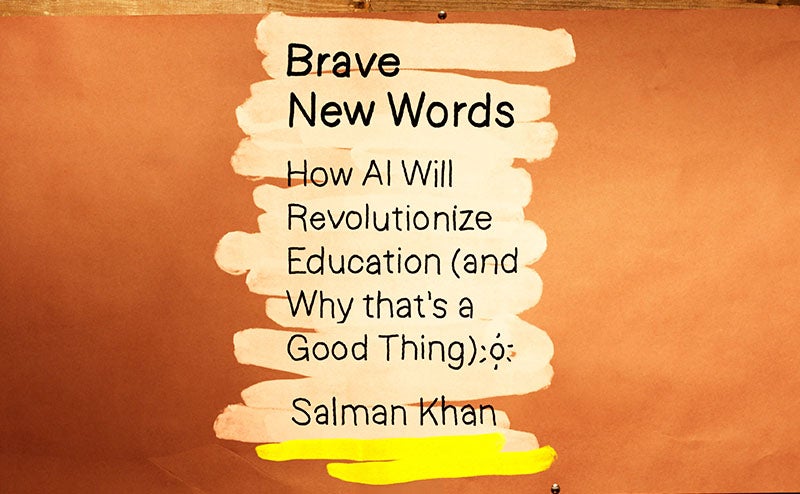
Brave New Words paints an inspiring picture of AI in the classroom.

Infectious Generosity is a timely, inspiring read about philanthropy in the digital age.

The Women gave me a new perspective on the Vietnam War
Kristin Hannah’s wildly popular novel about an army nurse is eye-opening and inspiring.
This is my personal blog, where I share about the people I meet, the books I'm reading, and what I'm learning. I hope that you'll join the conversation.

Q. How do I create a Gates Notes account?
A. there are three ways you can create a gates notes account:.
- Sign up with Facebook. We’ll never post to your Facebook account without your permission.
- Sign up with Twitter. We’ll never post to your Twitter account without your permission.
- Sign up with your email. Enter your email address during sign up. We’ll email you a link for verification.
Q. Will you ever post to my Facebook or Twitter accounts without my permission?
A. no, never., q. how do i sign up to receive email communications from my gates notes account, a. in account settings, click the toggle switch next to “send me updates from bill gates.”, q. how will you use the interests i select in account settings, a. we will use them to choose the suggested reads that appear on your profile page..

- Business & Money

Download the free Kindle app and start reading Kindle books instantly on your smartphone, tablet, or computer - no Kindle device required .
Read instantly on your browser with Kindle for Web.
Using your mobile phone camera - scan the code below and download the Kindle app.

Image Unavailable

- To view this video download Flash Player

Good to Great by Jim Collins | Key Takeaways, Analysis & Review Paperback – February 5, 2016
- Print length 40 pages
- Language English
- Publisher iDreamBooks
- Publication date February 5, 2016
- Dimensions 5 x 0.08 x 7.99 inches
- ISBN-10 1944195807
- ISBN-13 978-1944195809
- See all details

Product details
- Publisher : iDreamBooks (February 5, 2016)
- Language : English
- Paperback : 40 pages
- ISBN-10 : 1944195807
- ISBN-13 : 978-1944195809
- Item Weight : 1.76 ounces
- Dimensions : 5 x 0.08 x 7.99 inches
- #3,313 in Investment Analysis & Strategy
Customer reviews
Customer Reviews, including Product Star Ratings help customers to learn more about the product and decide whether it is the right product for them.
To calculate the overall star rating and percentage breakdown by star, we don’t use a simple average. Instead, our system considers things like how recent a review is and if the reviewer bought the item on Amazon. It also analyzed reviews to verify trustworthiness.
- Sort reviews by Top reviews Most recent Top reviews
Top reviews from the United States
There was a problem filtering reviews right now. please try again later..
Top reviews from other countries
- Amazon Newsletter
- About Amazon
- Accessibility
- Sustainability
- Press Center
- Investor Relations
- Amazon Devices
- Amazon Science
- Sell on Amazon
- Sell apps on Amazon
- Supply to Amazon
- Protect & Build Your Brand
- Become an Affiliate
- Become a Delivery Driver
- Start a Package Delivery Business
- Advertise Your Products
- Self-Publish with Us
- Become an Amazon Hub Partner
- › See More Ways to Make Money
- Amazon Visa
- Amazon Store Card
- Amazon Secured Card
- Amazon Business Card
- Shop with Points
- Credit Card Marketplace
- Reload Your Balance
- Amazon Currency Converter
- Your Account
- Your Orders
- Shipping Rates & Policies
- Amazon Prime
- Returns & Replacements
- Manage Your Content and Devices
- Recalls and Product Safety Alerts
- Conditions of Use
- Privacy Notice
- Consumer Health Data Privacy Disclosure
- Your Ads Privacy Choices
Press Herald
Account Subscription: ACTIVE
Questions about your account? Our customer service team can be reached at [email protected] during business hours at (207) 791-6000 .
- Local & State
Observe Memorial Day with these events in southern Maine
Tons of towns have parades and ceremonies happening Monday.

You are able to gift 5 more articles this month.
Anyone can access the link you share with no account required. Learn more .
With a Press Herald subscription, you can gift 5 articles each month.
It looks like you do not have any active subscriptions. To get one, go to the subscriptions page .
Loading....

Kids and adults gather at a Memorial Day parade to honor and celebrate veterans in South Portland. Sofia Aldinio/ Staff Photographer
BATH 10 a.m. Monday. Parade begins at 200 Congress Ave. and concludes at Library Park and will be followed by a wreath-laying service at 11 a.m.
BERWICK 11 a.m. Monday. Parade begins at Berwick Town Hall/Sullivan Square and proceeds to Lord’s Cemetery by way of Wilson and Allen streets. After a ceremony there, the parade will continue down Saw Mill Hill Street with a pause at the Somersworth-Berwick Bridge for a brief memorial service for those lost at sea. The parade ends at Sullivan Square with a memorial service honoring area veterans.
BIDDEFORD-SACO Opening ceremony at 9:55 a.m. Monday at Saco City Hall. Parade starts at 10 a.m. from Saco City Hall and proceeds along Main Street and down York Hill into Biddeford, continues along Main Street, onto Alfred Street and finishes at Veteran’s Memorial Park with a closing ceremony at 10:45 a.m.
BRUNSWICK-TOPSHAM 9 a.m. Monday. Parade proceeds from Topsham Town Hall, pauses for observances while crossing the Brunswick-Topsham bridge, and concludes at the Brunswick Mall.
CAPE ELIZABETH 9 a.m. Monday. Parade begins at the middle school parking lot, turns right on Scott Dyer Road, right onto Route 77 and ends at the village green adjacent to the town hall. A brief ceremony and laying of the wreath will be held at the Village Green after the parade.
CUMBERLAND 8 a.m. Monday. Kids run at Greely High School followed by 5K Run and Remember race at 8:30 a.m. Parade starts at 10 a.m. at Mabel I. Wilson School and ends at the veterans’ monument in Moss Side Cemetery in Cumberland Center, where a ceremony will be held at 10:30 a.m. Advertisement
FALMOUTH 10 a.m. Monday. Parade proceeds from 65 Depot Road (Falmouth American Legion) to Pine Grove Park, where a ceremony will be held.
FREEPORT 9:30 a.m. Monday. Parade proceeds from Holbrook Street, heads north on Main and makes a right onto School Street, then right onto Park Street, ending in Memorial Park. There will be a small ceremony in Memorial Park starting at 10 a.m.
GORHAM 11 a.m. Monday. Parade starts at Village School (12 Robie St.) and ends at Eastern Cemetery on Johnson Road.
GRAY 11:30 a.m. Monday. Parade leaves the Russell School (8 Gray Park), proceeds to Shaker Road and continues to the Soldiers Monument at the intersection of Routes 26 and 3 for a wreath-laying ceremony. Parade continues north to the American Legion Post (15 Lewiston Road) for a closing ceremony.
LYMAN 1 p.m. Monday. Parade starts at Waterhouse Road/Mill Pond in Goodwins Mills and ends at the Lyman Town Hall on South Waterboro Road.
NEW GLOUCESTER 9 a.m. Monday. Parade leaves from Memorial Elementary School (86 Intervale Road) and heads down Intervale Road to Route 100/202 to Veterans Park for a memorial service. The parade will reconvene and go down Peacock Hill Road, then take a left on Gilmore Road. Advertisement
OLD ORCHARD BEACH 1 p.m. Monday. Parade starts at the corner of Ballpark Way and E. Emerson Cumming Boulevard and proceeds down Saco Avenue, Old Orchard Beach Street to First Street and ends at Veteran’s Memorial Park.
PORTLAND 2 p.m. Monday. The procession starts at Longfellow School (432 Stevens Ave.) and ends at Evergreen Cemetery for a commemoration ceremony.
SANFORD 10 a.m. Monday. The parade starts at the Sanford Armory (88 William Oscar Emery Drive), proceeds up Gowen Park Drive and ends at Central Park.
SCARBOROUGH 10 a.m. Monday. Parade starts at Scarborough High School, turns onto Route 114 and then Route 1, past town offices to the Maine Veterans Home and concludes with a ceremony there.
SOUTH PORTLAND 10:30 a.m. Monday. Parade starts at Southern Maine Community College parking lot, proceeds down Broadway to the Veterans Monument for a short Memorial Day recognition service.
WELLS 9 a.m. Monday. Parade starts at Wells High School (200 Sanford Road) and proceeds to Ocean View Cemetery for a ceremony and musical performances. Advertisement
WESTBROOK 10 a.m. Monday. Parade proceeds down Main Street and will be followed by a ceremony in Riverbank Park.
WINDHAM 9 a.m. Monday. Parade starts at Windham Town Hall and proceeds onto Route 202 toward Windham High School. At 10 a.m., there will be a ceremony in front of Windham’s Veterans Memorial Flagpole at Windham High School.
YARMOUTH 10 a.m. Monday. Parade leaves from Yarmouth High School (286 West Elm St.) and proceeds to the Memorial Green at Town Hall for a ceremony.
YORK 10 a.m. Monday. Parade starts near St. Christopher’s Church (4 Barrell Lane) and proceeds down York Street to York Town Hall.
Success. Please wait for the page to reload. If the page does not reload within 5 seconds, please refresh the page.
Enter your email and password to access comments.
Forgot Password?
Don't have a commenting profile? Create one.
Hi, to comment on stories you must create a commenting profile . This profile is in addition to your subscription and website login. Already have a commenting profile? Login .
Invalid username/password.
Please check your email to confirm and complete your registration.
Create a commenting profile by providing an email address, password and display name. You will receive an email to complete the registration. Please note the display name will appear on screen when you participate.
Already registered? Log in to join the discussion.
Only subscribers are eligible to post comments. Please subscribe or login first for digital access. Here’s why .
Use the form below to reset your password. When you've submitted your account email, we will send an email with a reset code.
Send questions/comments to the editors.
In Camden, a story of wealthy neighbors, ocean views and over $1.7 million in fines
More than half of food-insecure mainers can’t get food stamps, skowhegan woman learns to heal from nearly 20 years of stepfather’s ‘cult-like’ abuse, for better burgers, up your bun game with these maine-made rolls, james pak, biddeford landlord convicted of killing 2 teenage tenants, dies in prison, daily headlines.
- Email address
- Hidden Untitled
- Phone This field is for validation purposes and should be left unchanged.
Member Log In
Please enter your username and password below. Already a subscriber but don't have one? Click here .
Not a subscriber? Click here to see your options

Frankly Fabulous

Location & Hours
Suggest an edit
1890 W El Norte Pkwy
Escondido, CA 92026
Via Vida Nueva & Rosemary Ct
You Might Also Consider

The Diamond Connection
Andrea G. said "I'm using my wife's yelp account to write this review because I honestly don't think people should have to download an app and take time out of their own schedule to praise a business or sales person for doing their job correctly.…" read more
in Jewelry, Diamond Buyers

Glaser & Bailey Awards
5.0 miles away from Frankly Fabulous
Tiffany T. said "I wanted to take the time to say a HUGE THANK YOU to the Staff at Glaser-Bailey Awards, Inc. I had waited until the last minute(day before) to get Trophies for a Golf Tournament. I had originally called Rex Trophies located in Poway…" read more
in Trophy Shops, Engraving

Day to Day Vintage
Sabrina N. said "this place is honestly kind of perf. def a gem of north park. was on a stroll and randomly came upon this pretty store. ended up buying some of my fave clothes from here. prices are dece, there is a huge variety of clothes, so there…" read more
in Men's Clothing, Women's Clothing, Used, Vintage & Consignment
Amenities and More
6 More Attributes
About the Business
Business owner information
Business Owner
At Frankly Fabulous, we believe that every woman deserves to feel confident and fabulous. That's why we offer a carefully curated selection of clothing, jewelry, accessories, and gifts that are as unique and special as you are. …
Ask the Community
Ask a question
Yelp users haven’t asked any questions yet about Frankly Fabulous .
Recommended Reviews
- 1 star rating Not good
- 2 star rating Could’ve been better
- 3 star rating OK
- 4 star rating Good
- 5 star rating Great
Select your rating
Overall rating

This charming boutique is a great new addition to Escondido's Country Club neighborhood, in the little shopping plaza of West El Norte across from the Blue Mug. Frankly Fabulous carries all kinds of gifts, apparel, jewelry, and more. They pride themselves in featuring "one of a kind Fabulous Finds". My wife and I were so impressed with the variety and selection, as well as the pricing. We actually spent quite some time looking at many of these wonderful items before purchasing a gift for our daughter. I had a good laugh at a few of the clever items they featured, including the "Blind Date with a Book" and the many great and fun cards. Cynthia, the owner, is a delight, and provides wonderful service. Frankly Fabulous is "must visit" addition to the neighborhood. With a $500 shopping spree giveaway coming up with registration by 2/29/2024 and Valentines Day coming up you have a couple of good reasons to make this a stop.

Wonderful new little neighborhood shop for wimen's clothing, gifts, jewelry and more. I enjoyed the conversation with shop owner and had a great time mixing and matching pieces for an upcoming trip. Great place for husbands to shop for their wives too, just sayin'
I really enjoyed my shopping experience at Frankly Fabulous today! The owner, Cynthia is warm and welcoming and helped me with my selection. I found a beautiful popcorn poncho in my favorite color as well as an accessory. She offers a great selection of unique gift items, women's clothing and accessories. I will definitely be shopping here again, and I highly recommend it!

Kim Quang Jewelry Inc
Nina T. said "We discovered Kim Quang over 20 years ago. Our family always goes to them for our jewlery needs. Great selection, prices, and service. You can find anything for any occasion." read more

Footwear etc.
10.7 miles away from Frankly Fabulous
Lesley S. said "My orthopedic MD suggested different shoes and gave me a referral to Footware etc. My first pair - what the Dr ordered - didn't work for me. They were rocker bottom. I returned them to the store a few days later and we found the…" read more
in Shoe Stores, Accessories
People Also Viewed

Lilz Boutique

SassyGee Boutique

Twice On Main Street

Glitz N’ Grand

CJ Gift Shoppe

Metaphor Boutique

Finely Home
Browse Nearby
Restaurants
Things to Do
Thrift Stores
Other Places Nearby
Find more Accessories near Frankly Fabulous
Find more Jewelry near Frankly Fabulous
Find more Women's Clothing near Frankly Fabulous
Related Cost Guides
Frankly Fabulous is a Yelp advertiser.

IMAGES
VIDEO
COMMENTS
The Findings. The findings of the Good to Great study will surprise many readers and shed light on virtually every area of management strategy and practice. The findings include: Level 5 Leaders: The research team was shocked to discover the type of leadership required to achieve greatness. The Hedgehog Concept (Simplicity within the Three ...
Jim Collins - Good To Great Book Review & Key Takeaways Jim Collins' research team found that the first ingredient for greatness was a leader with a paradoxical blend of personal humility and professional will. Unlike many would expect, individuals at the helm of companies considered to be great were not high-profile leaders with some previous claim to fame.
Good To Great by Jim Collins is a book that has been sitting on my bookshelf for awhile now. I finally got a chance to read it, and wanted to share an in-depth review of some of the lessons I learned in it. The amount of research and analysis that has gone into this book is mind-boggling. A research team of over 25 people, headed by Jim Collins ...
Review: Good to Great is a seminal book that has had a profound impact on the business world since its publication. Jim Collins presents a well-researched and thought-provoking framework that ...
Good to Great Book Review . Winder Family . Videos for this product. 0:40 . Click to play video. A True Classic in the Business World. Chris Huff . Videos for this product. ... Jim has also published two monographs that extend the ideas in his primary books: Good to Great and the Social Sectors and Turning the Flywheel. His most recent ...
Good to Great by Jim Collins is a book about why some companies become great while others merely remain good. At its core is the idea of the flywheel: Flywheel from Good to Great by Jim Collins. The book is broken down into 9 chapters: Good is the Enemy of Great. Level 5 Leadership. First Who….
Book Summary. To find the keys to greatness, Collins's 21-person research team read and coded 6,000 articles, generated more than 2,000 pages of interview transcripts and created 384 megabytes of computer data in a five-year project. The findings will surprise many readers and, quite frankly, upset others. Built to Last, the defining management ...
Title: Good to Great Author: James C. Collins Publisher: Harper Business Genre: Business, Strategy First Publication: 2001 Language: English Book Summary: Good to Great by James C. Collins. To find the keys to greatness, Collins's 21-person research team read and coded 6,000 articles, generated more than 2,000 pages of interview transcripts, and created 384 megabytes of computer data in a ...
Every good-to-great company faced significant adversity along the way to greatness. In confronting the brutal facts, they left themselves stronger and more resilient, not weaker and more discouraged. There is a sense of exhilaration that comes in facing the hard truths and saying, "we will never give up.".
The Amazon Book Review Book recommendations, author interviews, editors' picks, and more. Read it now. ... Jim has also published two monographs that extend the ideas in his primary books: Good to Great and the Social Sectors and Turning the Flywheel. His most recent publication is BE 2.0 (Beyond Entrepreneurship 2.0), an ambitious upgrade of ...
From becoming a level 5 leader to improving your way of thinking and acting, Good to Great provides all the advice you need to help your organisation flourish and grow. The book has been translated into 32 languages and has featured on many bestseller lists, including those of the Wall Street Journal and the New York Times, for several months ...
Influential management professor Jim Collins released the popular Good to Great: Why Some Companies Make the Leap…and Others Don't in 2001. The book is really a research project led by Collins as a follow-up to his book Built to Last: Successful Habits of Visionary Companies.He researched hundreds of companies to identify sets of "good" companies where one became "great" while a ...
To summarize what it takes to go from good to great, Collins says it's a discipline at the three key levels: Disciplined people: great people focused on excellence and the hedgehog strategy. Disciplined thought: honesty and openness. Disciplined action: unrelenting focusing on what matters, putting first things first.
Sep 22, 2017. Good to Great, by JIm Collins. My third book in this book review series is the most recommended. As someone who purposely pursued an MPA rather than an MBA, I don't usually ...
By Jim Collins (2001) Pages: 210, Final verdict: Should-read. Can a good company become a great company and, if so, how? This is the question answered in the 2001 best-seller Good to Great by Jim Collins, an American former business consultant, researcher and author.. Collins's first book, Built to Last, detailed the study of a group of companies which endured for many decades.
Post contents. With over four million copies sold to date, Good to Great by Jim C. Collins is one of the best-selling management books of all time. The follow-up to his international bestseller, Built to Last, Good to Great focuses on how both mediocre and good companies can go beyond their stagnant status-quo to become great organizations.
After the leap, the good-to-great companies generated cumulative stock returns that beat the general stock market by an average of seven times in fifteen years, better than twice the results delivered by a composite index of the world's greatest companies, including Coca-Cola, Intel, General Electric, and Merck. ... he has authored or ...
Good to Great :: Why Some Companies Make the Leap &_Others Dont_. Paperback. by James C. Collins (Author) 4.4 227 ratings. See all formats and editions. To find the keys to greatness, Collins's 21-person research team read and coded 6,000 articles, generated more than 2,000 pages of interview transcripts and created 384 megabytes of computer ...
The Findings. The findings of the Good to Great study will surprise many readers and shed light on virtually every area of management strategy and practice. The findings include: Level 5 Leaders: The research team was shocked to discover the type of leadership required to achieve greatness. The Hedgehog Concept (Simplicity within the Three ...
Each of the good to great compa-nies exhibited Level 5 leadership, which isn't what most would expect. Level 5 leadership is humil-ity + will, devoid of ego but not ambition. The ambition is for the organization's success more than personal recognition. A whole chapter describes Level 5 leader-ship in some detail.
On balance. Overall, I think that Good to Great provides a very useful model and framework for developing and creating a great business. Concepts such as the flywheel go some way to challenging the 'magic bullet' fascination within the business world. Similarly, a Level 5 leader in place of 'Fred the Shred' might have created a very ...
Good Material, by Dolly Alderton. Alderton's novel, about a 35-year-old struggling to make sense of a breakup, delivers the most delightful aspects of romantic comedy — snappy dialogue ...
Common Sense is the nation's leading nonprofit organization dedicated to improving the lives of all kids and families by providing the trustworthy information, education, and independent voice they need to thrive in the 21st century. Common Sense Media is the leading source of entertainment and technology recommendations for families.
Throughout the book Collins gives great examples for each discipline and its component and how it either went from good to great or continued to be good. Along with the examples Collins provides pleather of diagrams and charts in the appendix, which becomes a great reference for the reader and creates a better understanding of what is needed to ...
Apple MacBook Air (15-inch, M2, 2023) Apple's MacBook takes the best of the 13-inch M2 Air and enlarges it. With a better speaker system, better performance, and a relatively accessible price tag ...
Yoga Book 9i (2024) 6.5 / 10. With a Core Ultra CPU, up to 32GB of RAM, up to 1TB of storage, and an OLED display, this convertible, dual-screen laptop from Lenovo is a capable, premium machine ...
As a result, even though some of its advice may seem fairly rudimentary, the book is now my favorite of anything David has written. While reading How to Know a Person, I took a ton of notes and reflected on my own communication style. In Chapter 6, "Good Talks," David dives into what makes a conversation meaningful.
In Good to Great: Why Some Companies Make the Leap...And Others Don't, Jim Collins offers insight into what makes a business truly great. Read more. Continue reading Read less. Previous page. Print length. 40 pages. Language. English. Publisher. iDreamBooks. Publication date. February 5, 2016. Dimensions. 5 x 0.08 x 7.99 inches. ISBN-10.
Kids and adults gather at a Memorial Day parade to honor and celebrate veterans in South Portland. Sofia Aldinio/ Staff Photographer. BATH. 10 a.m. Monday. Parade begins at 200 Congress Ave. and ...
3 reviews and 29 photos of FRANKLY FABULOUS "This charming boutique is a great new addition to Escondido's Country Club neighborhood, in the little shopping plaza of West El Norte across from the Blue Mug. Frankly Fabulous carries all kinds of gifts, apparel, jewelry, and more. They pride themselves in featuring "one of a kind Fabulous Finds".